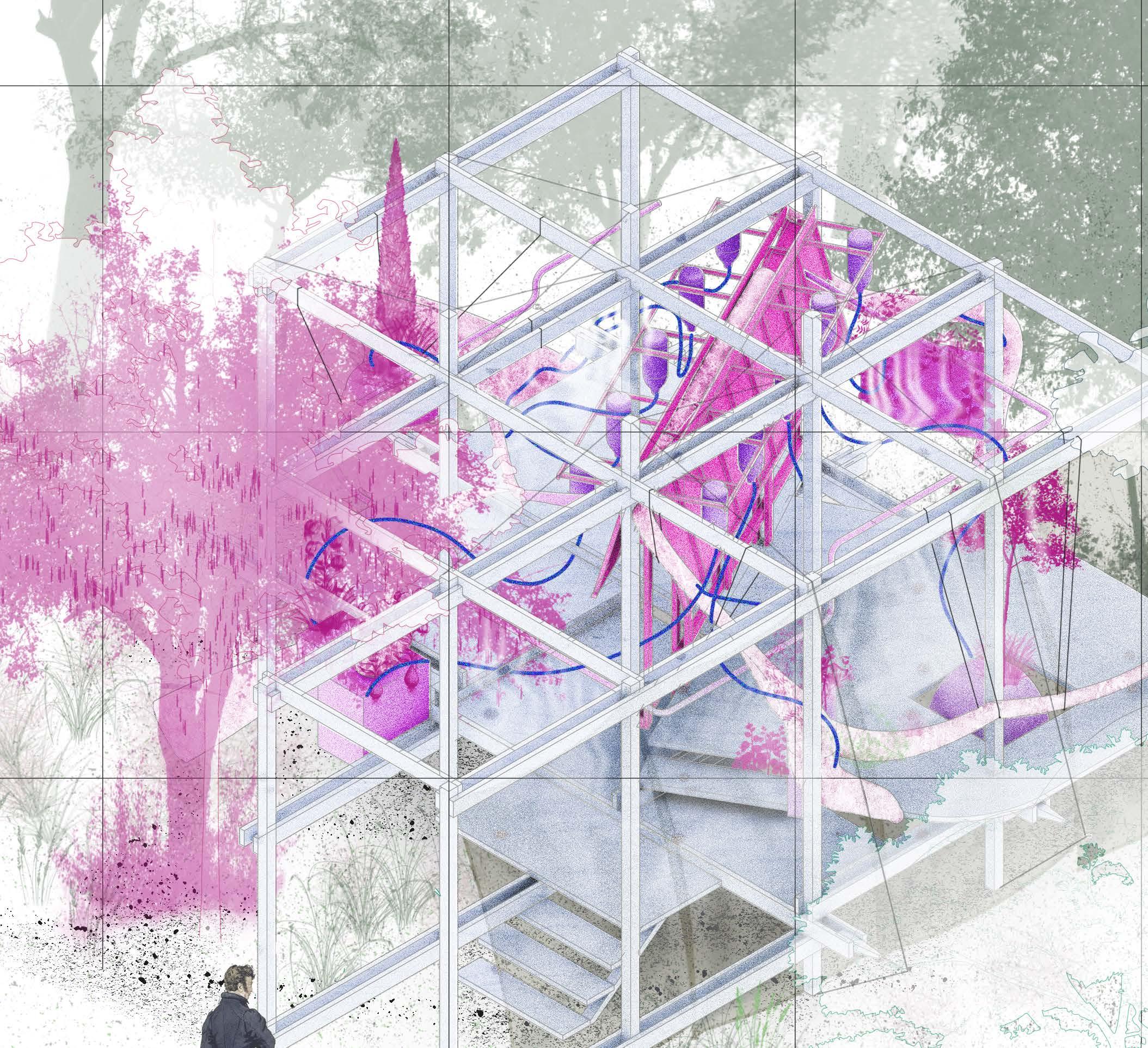
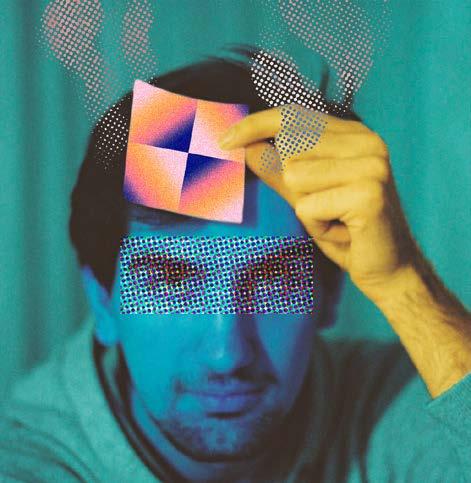
Contact email: mertkaanalptekin@gmail.com behance: www.behance.net/mertkaanalptekin instagram: @m.k.a.an vimeo: vimeo.com/mertkaanalptekin
I am a young architect currently pursuing a Master’s in Architectural Design at Istanbul Technical University. During my undergraduate education at ITU, I cultivated a strong interest in the theoretical dimensions of architecture, especially its intersections with the sciences, humanities, and philosophy. My recent projects, including my diploma work, have delved into themes such as posthumanism and ontology, emphasizing how design can address larger societal and urban challenges.
Education
İstanbul Technical University Master of Architecture
İstanbul Technical University
Bachelor of Architecture
İstanbul Techincal University
School of Foreign Languages (Proficiency 86.00/100)
İzmir Atatürk High School
Experience
Trash Peaks and Debris: (Un) becoming Architecture, Studio Exhibition at Salt Galata Team Member/Exhibition
Trash Peaks and Debris: (Un)becoming Architecture, Studio Exhibition at 3rd Upcycle Art and Design Festival, Müze Gazhane Team Member/Exhibition
EELISA Circle@[action], String Figures of the Wasteterrain
Participant/Workshop
EELISA circle@[action], R-mechanism
Participant/Workshop
Yalın Mimarlık Internship/Office
EASA Parti’le! Workshop Participant/Workshop
Rota Mimarlık Internship/Construction Site
Awards
MimED Project Awards for Architecture Students, 4th year category
Jury Special Award
İzmir University of Economics
Güzelbahçe Campus
Architectural Project
Competition, team work [insandışı - Team Leader: Nizam Onur Sönmez]
Purchase Prize
MimED Project Awards for Architecture Students, 3rd year category
1st Prize
MimED Project Awards for Architecture Students, 2nd year category
Jury Special Award 1
Jury Special Award 2
2020 MimED Project Awards for Architecture Students, 1st year category
1st Prize
lockeddown(in120homes) competition
Honorable Mention
Kısakes Lisevizyon Short Film Awards
Best Screenplay Award
Best Screenplay Award (with Ozan Oralalp and Arda Bozkurt)
*in-studio projects
chaotic soup of semantics, 'living' systems and geologies
Diploma Project
thermodynamic migrations and boundless machines
Architectural Design VII project
-MimED 2023 (Project Awards for Architecture Students), 4th year category
Jury Special Prize
re-creation of transhuman Architectural Design V project
in-situ institutes Architectural Design V project
-MimED 2021 (Project Awards for Architecture Students), 3rd year category
1st Prize
infra-twined-structures Architectural Design IV project
-MimED 2021 (Project Awards for Architecture Students), 2nd year category
Jury Special Prize
Hobbies and skills
filmmaking, analogue photography, digital photography, illustration, video editing, drawing
ENG
chaotic soup of semantics, 'living' systems and geologies
part of "trash peaks & debris: a struggle of an attempt for unbecoming an architecture" diploma project
Jury - Assoc. Prof. Dr. Sema Alaçam, Dr. Bihter Almaç, Assoc. Prof. Dr. Fethiye Ecem Edis, Assoc. Prof. Dr. Nizam
Onur Sönmez, Prof. Dr. Murat Cemal Yalçıntan Res. Assis. Ayşe Tuğçe Pınar Akın Res. Assis. Filiz Ayaz
The project aims to redefine an industrial waste site through a non-anthropocentric cosmos narrative. It is based on mechanisms that generate energy from waste, establishing and activating physical space through energy flows and material transformations. By questioning dualities such as life and inanimateness, human and nature, culture and civilization, the project determines the resilience and climate of space through the concept of porosity. Rather than being an engineering problem, the project is defined as a system composed of actors exhibiting meaningless and “folie” behaviors.
The project is located in the Gulf of Izmit, at the intersection of a wetland that was previously used as a wild garbage storage area and declared a natural conservation area. The area also hosted the Interteks Fairground building until it was recently dismantled, and the waste stored after the cleaning of the mucilage that covered the Marmara Sea in 2021 is also temporarily kept in this area.
This experiment aims to integrate into the waste-wetland area through a cosmos narrative that develops by questioning dualities such as human-nature, living-inanimate, and is nourished by a monist foundation while simultaneously encompassing multiple, non-holistic existences.
The intervention reconfigures conventional architectural programs and elements by including the environment and other non-human subjects in the context of energy flows and material transformations.
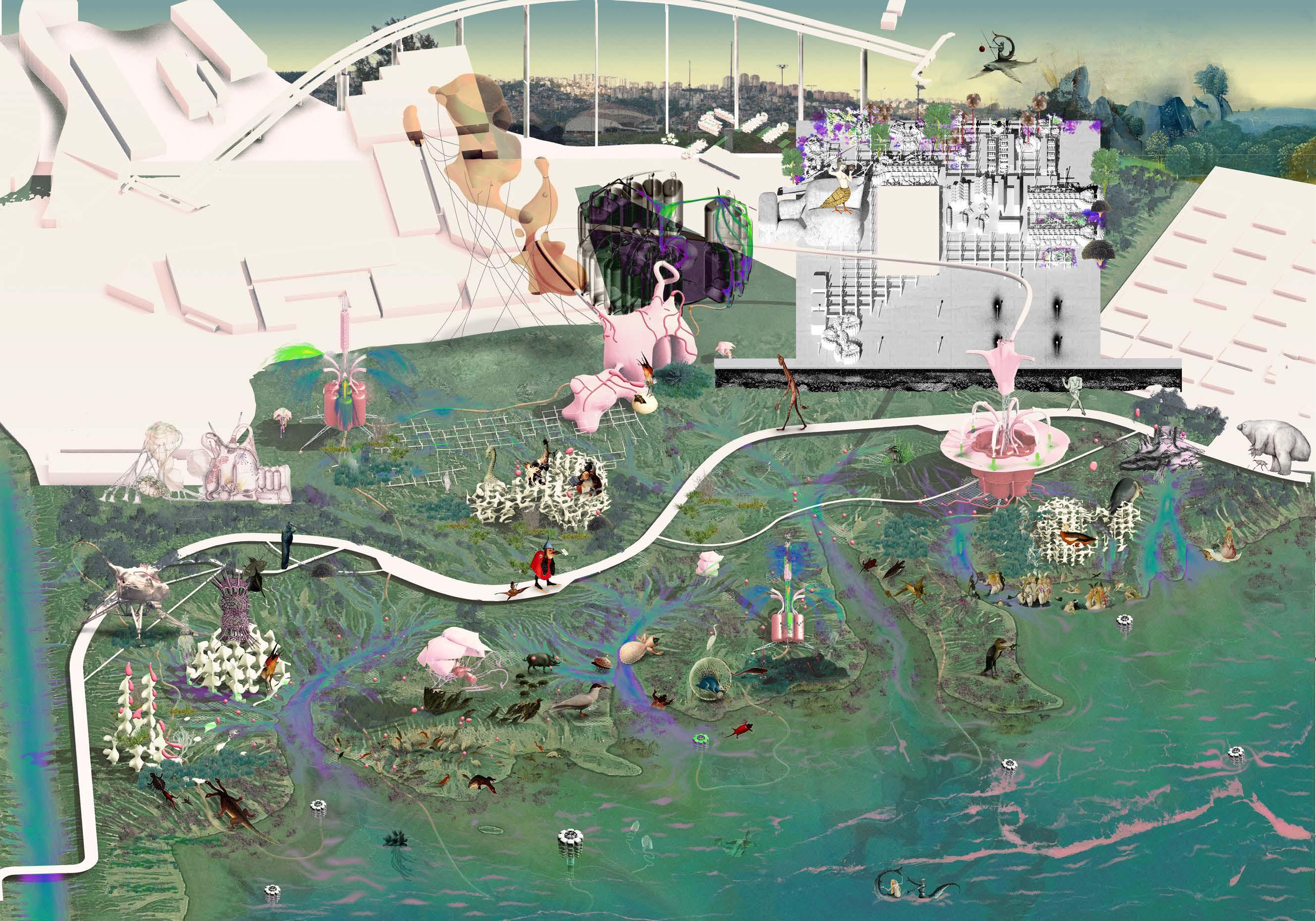
The porosity created by clusters scattered throughout the area, where the intervention materializes and continually changes through accumulations and erosions, distributes the climates and actions of the space. Instead of function, the mechanisms (‘folie’ mechanisms) existing through behaviors or meaningless feedback loops create potential meaning clusters through encounters and symbioses with various subjects.
Ultimately, the area transforms into a chaotic amalgam where symbiotic relationships, collisions, dialectical, mechanistic, and emergent formations continually reshape the topography. Now, like Hieronymus Bosch’s gardens, which are enriched by their hybrid creatures, their absurdities, and all the states of madness, pleasure and terror, this area has become a chaotic soup with techno-organic hybrid creatures, uncanny and exciting post-human subjects, and uncertain troubles in the sea and underground.
post-humanism
Although the philosophical and mental change that humanity, or more specifically Western society, has undergone since the beginning of the last half-millennium provided the human species with an evolutionary superiority that it had never had before and relative prosperity on a social basis, this change in perspective also had a value. Although the self-confidence that the humanist view brings to humans has provided the scientific, technological and even some political achievements so far, the urge to define a human being through an "other" has imprisoned us in paradigms that put us in vicious circles in the face of the disasters and crises we encounter or cause. Perhaps the hierarchical scheme that this perspective brings, starting from within the human being and gradually expanding, is the reason behind the obvious and hidden sociological, political, economic and ecological problems that we are struggling with today.
The human-nature duality and the hierarchical relationship scheme in which humans are at the top, which are also found within the human species, do not work. On the basis of this scheme, the climate crisis, repressed groups, wild capitalist growth, disposable culture, excessive consumption, immigrant problems and many other similar situations are the triggers of today's situations.
As we begin to comprehend the intricate relationships between our own actions as a human species

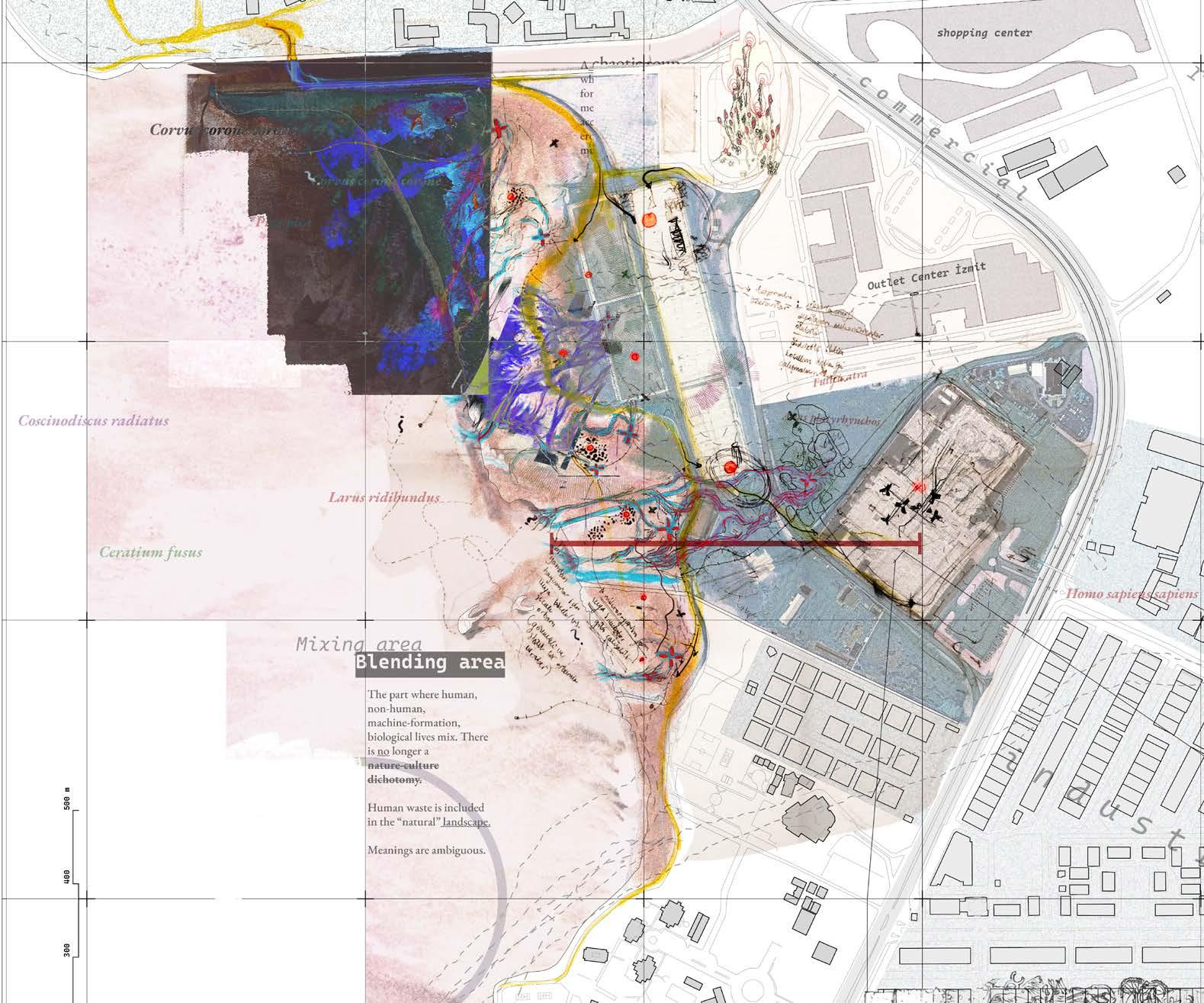
and the environment, and the troublesome conditions of the age we live in, the perspectives of the disciplines we define as positive sciences on the universe - as will mention later, the disciplines in question are not isolated and independent from other disciplines within these definitions - are transformed into a non-anthropocentric perspective by the nature of things. was dragged into position. On the other hand, the very societies that we define as the humanities and that they are interested in - especially those under the intense influence of the West - seem to be stuck between the contradictions created by the humanist perspective and the reality of our age. I believe that this in-betweenness triggers quite absurd situations and processes,
incompatible and contradictory perspectives within society when viewed from the outside.
### nature-culture dichotomy
Aside from these absurdities that we may encounter in daily life, we encounter many other contradictory approaches that can be described as protecting nature, restoring nature and "greenwashing", created by today's ecological situations and the humanist perspective of individuals acting in the background. The general attitude in these approaches is that humanism positions humans at the top in a hierarchical scheme and puts nature against the concept of "civilization" or



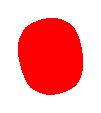





"culture" as the other. Although the role of nature has evolved over time, from wild to sublime, and today to defenseless and in need of protection, in these approaches, humans define themselves as a separate entity from nature. These approaches are futile efforts to achieve their intended gains.
Reading nature and humans on the same plane without humanizing them - seeing human actions as phenotypes
Before examining and intervening in the field, I think it is necessary to adopt a cosmos narrative that is pregnant with more possibilities and tries to examine existence and becoming from a more inclusive place, other than this inconsistent, half-humanist, half-anthropocentric messy situation.
Man must lose his hierarchical and discrete position.
It is obvious that the sociological perspectives based on the scientific narratives of the past centuries have become obsolete. The symbiogenetic combination of living things in different branches of the evolutionary tree to form a new living species, the diversification and branching of this living species through evolutionary processes, the mutual evolution of living things with the microbiome in their bodies and their integration in a way... These show that a hierarchical narrative may be erroneous. In this case, humans (specifically Braidotti's "Men") lose their hierarchical position and
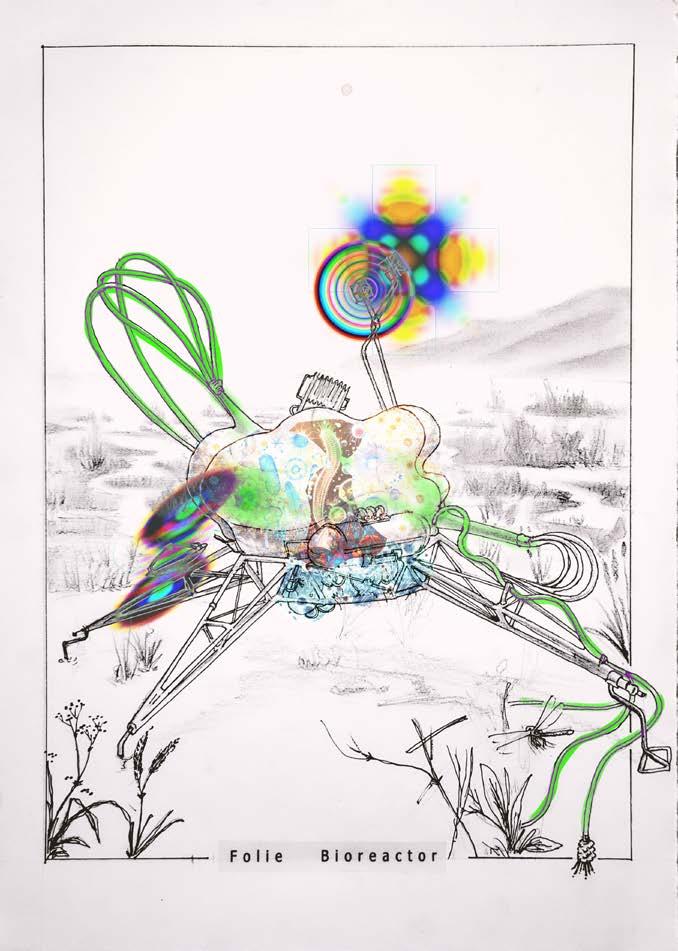
-cilia that swallow the surrounding water
-flora and fauna that begin to form around the fountains
-The contraction and relaxation of the sac agitates the medium inside it.
-The porous structures in the environment reveal new habitat possibilities.
-the vesicles at the bottom incubate the biota to be injected into the medium
- radiators that provide the optimal temperature in the sac

find a place for themselves in a networked relationship scheme. A dynamic cosmos with temporary assemblages instead of purity and linear development. In such a universe, humans and no human-related activity are in a separate position from the systems that we alienate as "nature". Human environment, industry and economic activities, culture are extensions of nature in the human context. In his book Extended Phenotype, Richard Dawkins argues that the behavior of
animals, and therefore the environment they create, should be defined as phenotype. This perspective basically makes all human productions and human sciences the subject of zoology, biology and, in a broader sense, ecology.

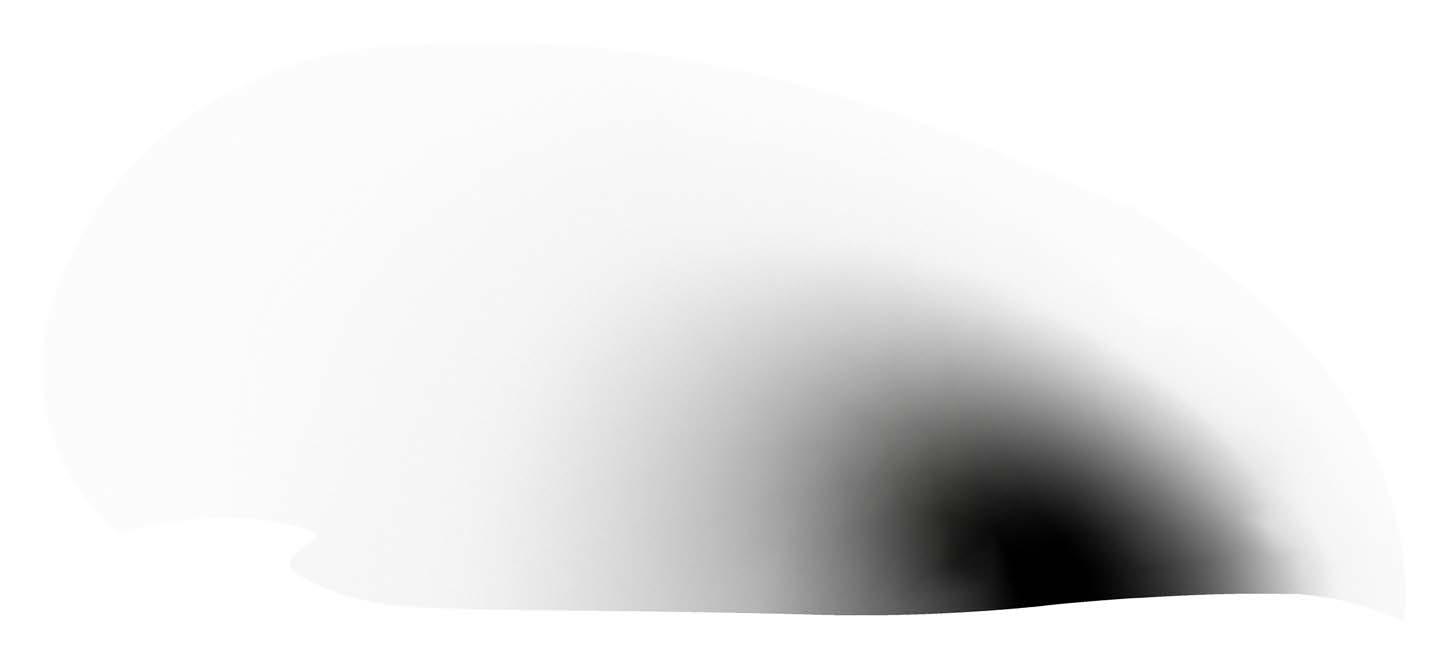
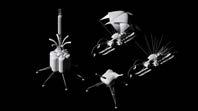





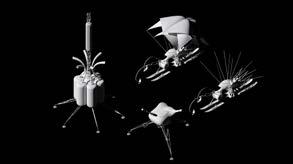
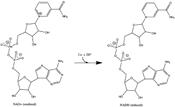


### definition of life and geology
In this ever-expanding circle of concepts, the next duality questioned may be about living matter and the mass of geological materials we live on, that is, about life and non-life. The geological features that affect the formation of ecosystems and the living matter that shapes geology (see climate crisis as a result of human activities, microplastic mines in the oceans, garbage dumps [anthropocene]) also question the legitimacy of this duality. In addition, it is a geological age that is the ability of the human species to shape the earth topographically (open mines), chemically and geomorphologically on large scales and is the irreversible result of these processes; Aside from the series of effects we can call -Anthropocene-; Our questions are strengthened by the existence of viruses, the geological origins of the necessary building blocks at the beginning of life, hives that we can describe as superorganisms, flocks of birds moving with simple algorithms, the termite nest being an organism as a whole, or the many gray areas we encounter, from simple mechanisms to complex robots and from there to artificial intelligence.
All of these point to a "vitalist materialist" perspective, built on the monist universe narrative that Braidotti borrowed from Spinoza. If we take the whole thing in this context, do we live in a fundamentally monist universe that consists of parts that differ by internal and external factors and are connected to each other by various relationships? This chaotic environment is also the creative force that creates all this diversity.
The area is in a position torn between being a habitat with high biodiversity created by the delta plain formed at the bottom of the Kocaeli Gulf and the wetlands that result from the meeting of the stream with the stream, and the geopolitical role of being the international trade, logistics and industrial crossroads of the country.

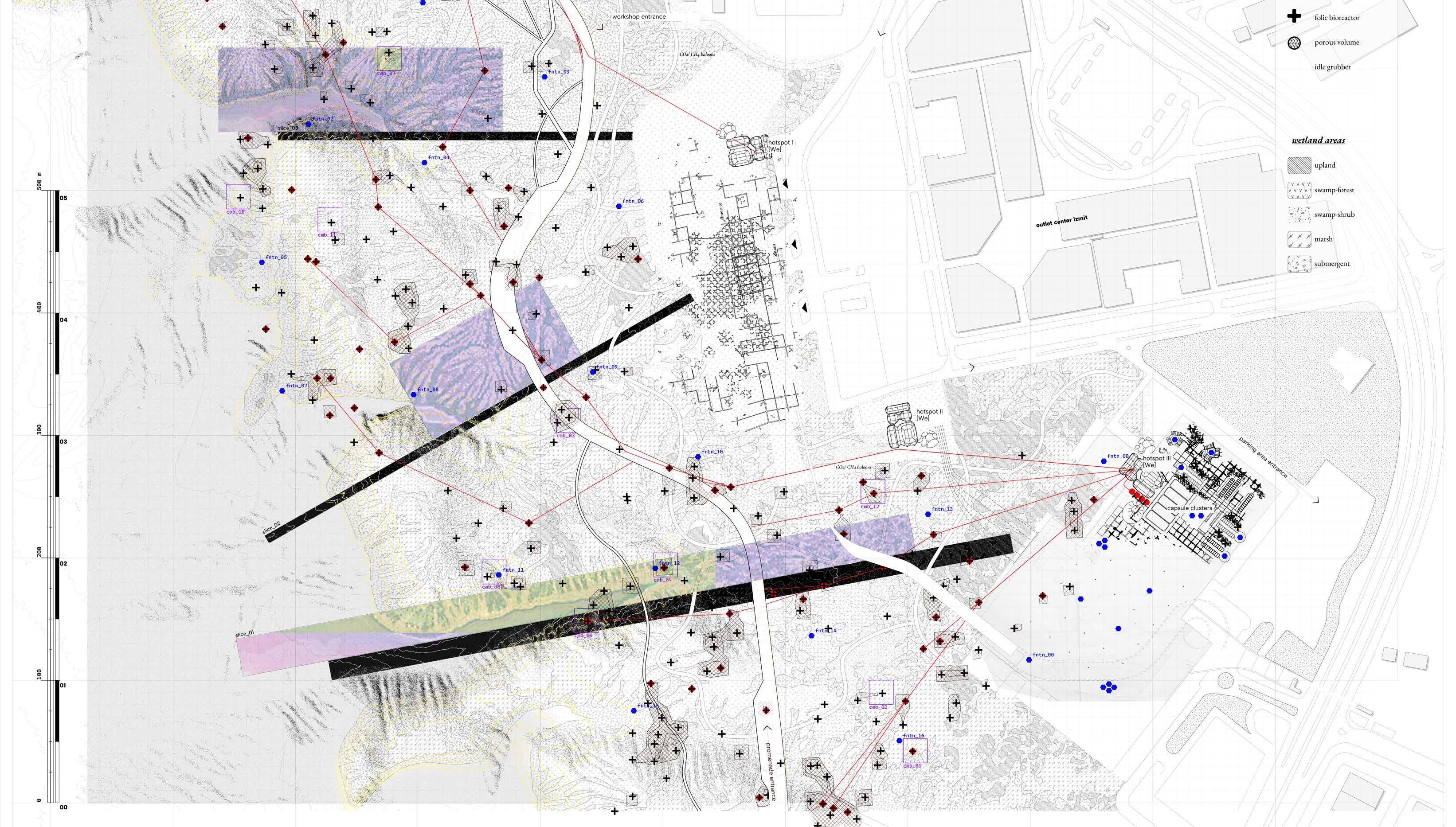

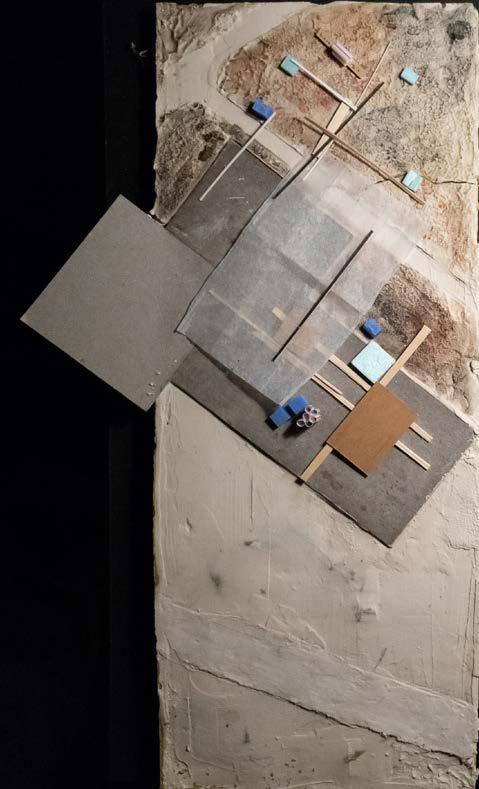

2.3. redefining space
Within the scope of the project, instead of examining the area through conventional architectural programs and schemes, I examined the movements and transfer of energy and the transformations of matter throughout these processes, in line with the cosmos narrative discussed at the beginning. This approach opens up many concepts and approaches: an anthropocentric or even non-organismocentric act of “construction”, the definition of life going beyond organisms, etc.
As a result; Instead of functions, volumes, circulation or axes assigned to these functions, a program is beginning to be established through "actors" that play a role in the flow of energy or the transformation of matter.
Based on this perspective, it is possible to define the act of "construction" and in a broader context as systems consisting of energy flows and matter changes. This perspective allows us to examine living matter and geological things on the same plane as the mechanisms and “actors” specific to this project.
This perspective will change how the "actors" planned to be added to the field will be perceived.
Just as there are no teleological qualities at the basis of life, meaningless feedback loops at the chemical level come together with evolutionary mechanisms, the mechanisms that will play an actor role in this field are expected to have behaviors and characters instead of having a defined function or predefined purposes. These behaviors are meaningless and, in a sense, of a “folie” nature. Thanks to their meaninglessness and undefinedness, they gain their meaning from the subjects they relate to. Meaninglessness means a kind of eternal meaning, it is shaped by subjects.
The region, which has been on various trade routes throughout history, remained an area avoided due to its wetland and swamp nature, especially until the last century. On the other hand, due to the strategic position the city has gained in the last century, industrial structures established in the city have begun to expand towards this region. Despite this development trend, we can infer that the document is despised from the fact that the area has been used as a garbage dump for the last 50 years. Although the situation of being a garbage dump disappeared to some extent with the construction of a fair building in the region in the 2000s, this building was also demolished for earthquake resistance reasons due to the nature of the ground and the quality it gained as a result of human intervention, causing the area to return to its state of being in the middle.
The qualities contained in the area open up many discussions in terms of geological, political, economic and ecological aspects, including on a global scale. Human intervention embedded in the area gives the area a dramatic and perhaps dystopian character brought by the Anthropocene age for the human species.
2.2. Not turning it into an engineering problem
When we think of a monster that does not lie very deep and whose reaction we do not know how it will react to every intervention that is considered to restore the area and nature, the futility of such interventions is thrown into our faces. Again, for this reason, I think that the problem in the field, or more accurately, the "issue", is something other than an engineering problem. Because of the way we see and approach the forehead, the Architect and the act of “building” wallow in this futility.
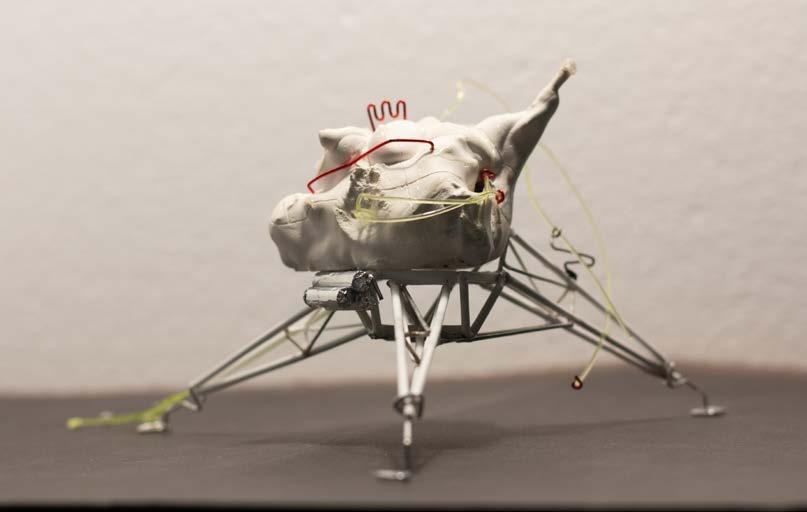
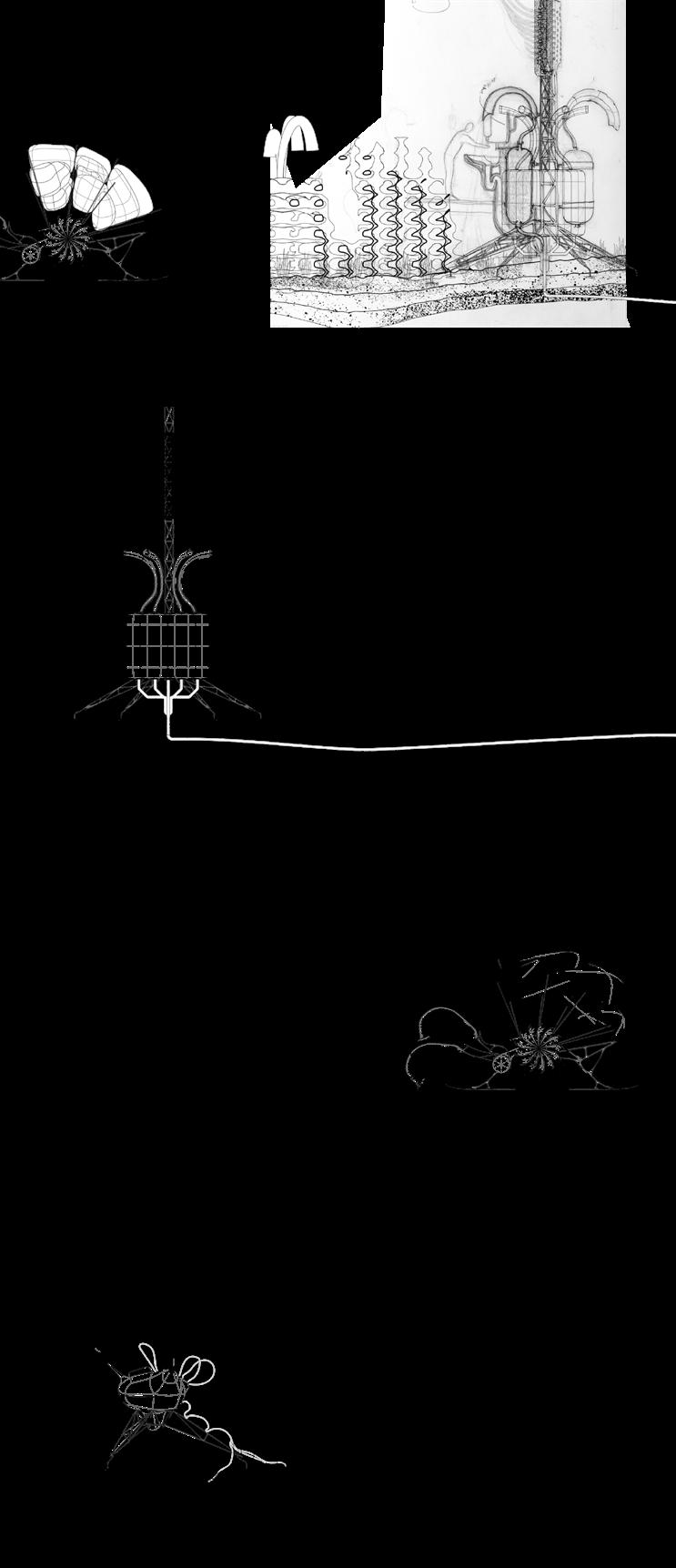

The definition of physical space is shaped through "porosity", which is also related to the aforementioned approach.
Porosity is defined in terms of the resistance of space to change and energy flows that are the result of countless radioactive, chemical, biochemical, thermodynamic processes in space. This quality also affects the physical and spatial qualities of the volume. The various climates that the volume will have, depending on its nature and the environment in which it is located, create a cloud of possibility in which various subjects can establish different relationships with the space.
The primary element that establishes the physical space and activates all non-material processes are the waste-to-energy plants, which are assigned the [We] code and defined as "hotspots" in the project. These regions are the volumes where the most intense energy movement and matter transformation occurs. Due to this activity, the volumes that will exist in the area are shaped around these centers, in a way like the living things clustered around the hydrothermal vents in the ocean depths.
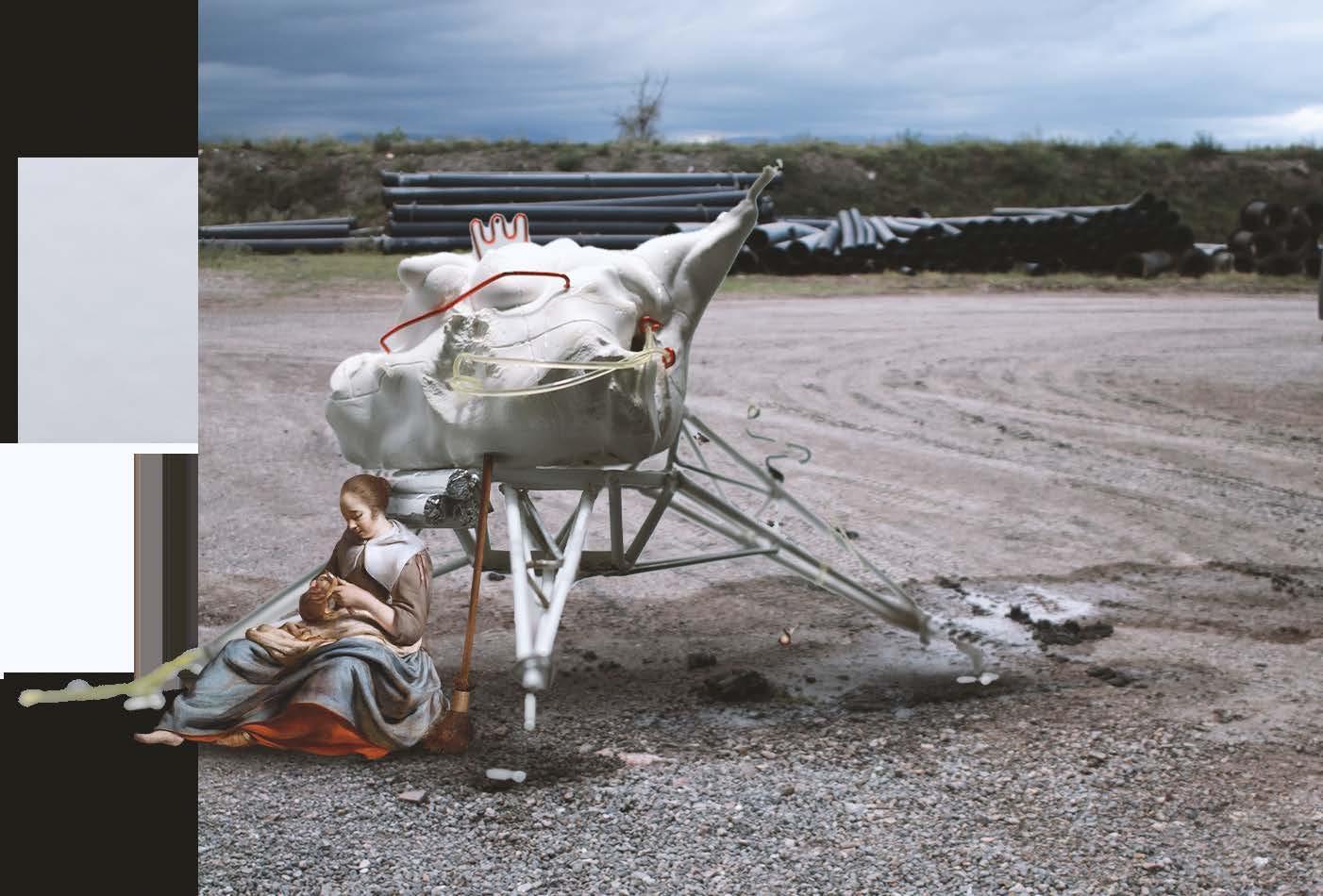



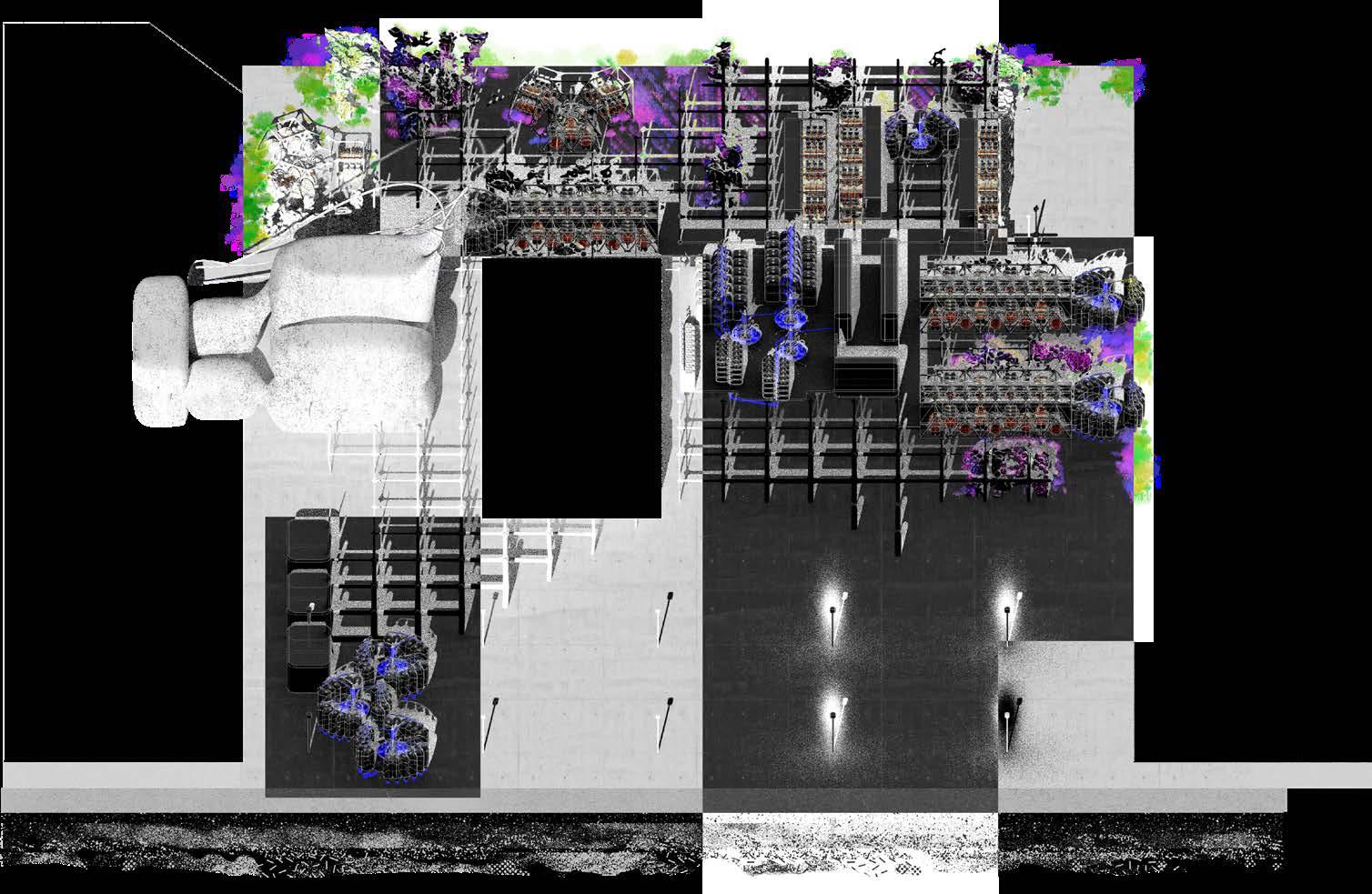

ENG
thermodynamic migrations and boundless machines
A cybernetic organism-like structure, where microclimates formed as a result of lithological and hydromorphological effects in the Göksu Basin provide habitat, bring these relations and areas together by mixing them.
MimED 2023 - Project Awards for Architecture Students, 4th year category/Jury Special Prize
In contrast to the holistic and telelogical narrative of the universe, the project incorporates a mechanistic but uncertain and probabilistic universe narrative into inquiries about the definitions and scopes of architecture and vitality. Due to its existence, it transforms the ecological, economic and sociological relations networks in the basin where the project is located, into a cybernetic organism-like that spreads across the geography and has a rigid body and no definite borders.
The “queer” components of this cybernetic organism-like are left to the Göksu Basin in the Taurus Mountains, which is formed as a result of lithological and hydromorphological effects, creating microclimates with their positioning; It is a mass of particles and formatives that are tossed under the influence of thermodynamic, ecological and economic relations and fields, mixing these relations and fields as they are thrown.
These particles, which gain their meaning from the context and the subject with which they are associated, and take their movements from the changing physical features of the geography, form microclimates that provide habitats for organisms of various scales at various time scales.
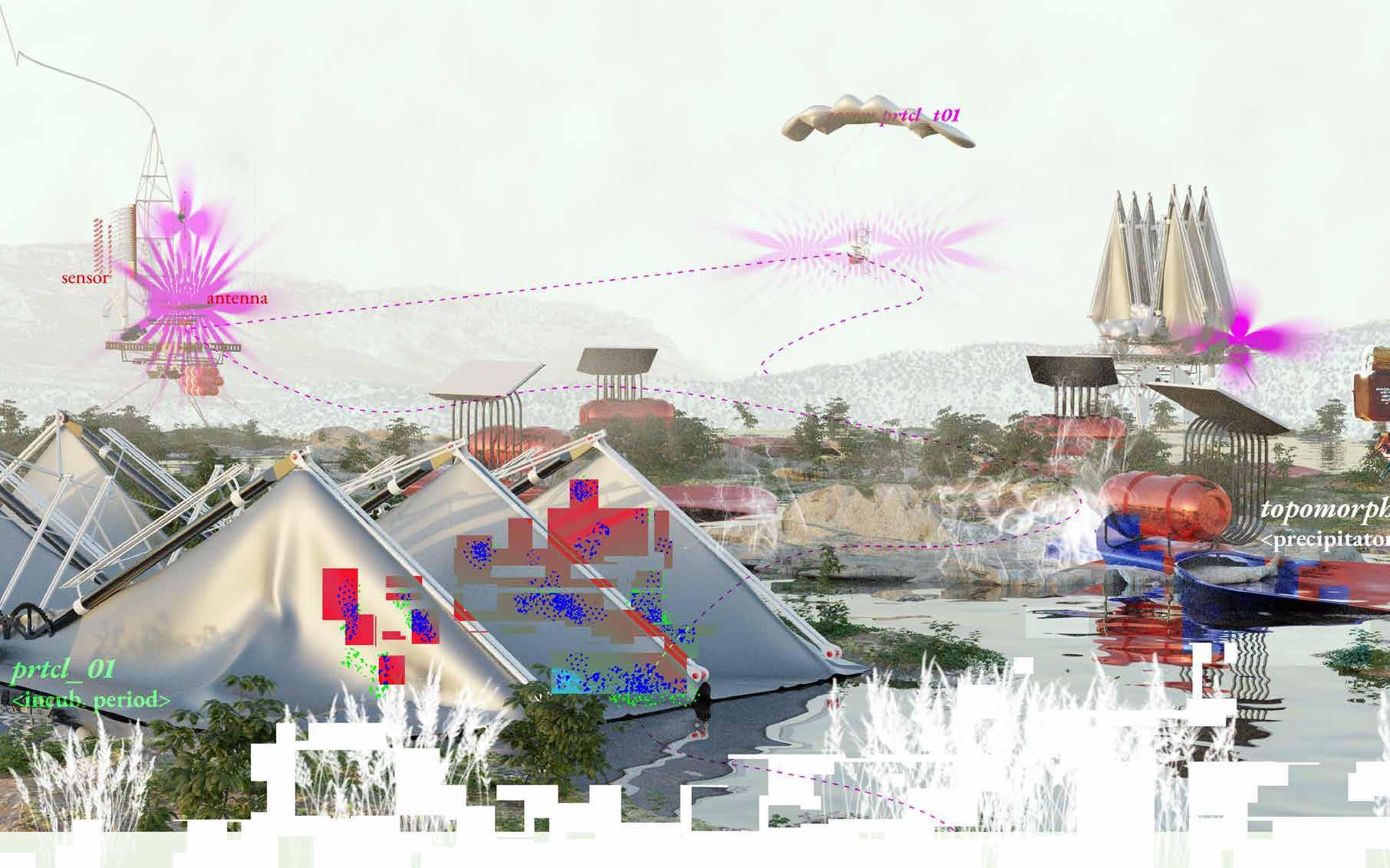
The limestone ocean floor, which is susceptible to erosion by water, has formed canyons and high, flat plateaus by the erosion of water currents and streams passing over it when it rise to the surface. Microclimates created by the canyon and the water current have enabled ecological niches and various flora and fauna to settle here and form ecological systems. Although there are harsher conditions on the plateaus compared to the canyons, the dolines formed by the erosion of the water provided the formation of isolated ecological niches and enabled endemic species to evolve in these niches. The duality of Iow, temperate, and fertile Plains formed by high, cold, and barren plateaus and canyons has enabled other cultural flows for the human species. The lifestyle of the nomads, who are on the Plain in winter, on the plateau in summer, and migrate between these two regions throughout the year, is almost integrated with this topography. Small cattle herds accompanying these migration movements, on the other hand, Play a critical role in the ecological system by providing the continuity of genetic diversity in microbiological, faunal, and floral terms by acting as a carrier
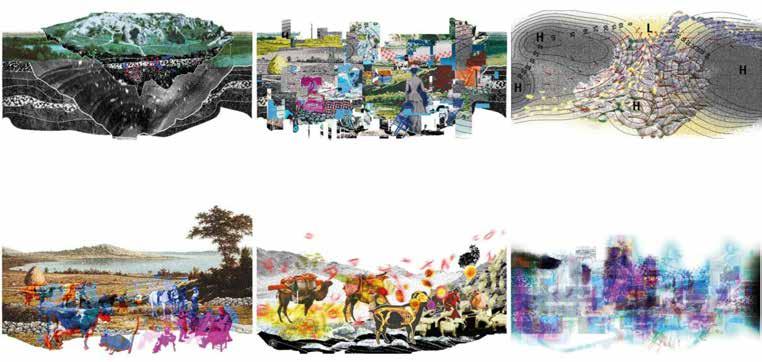

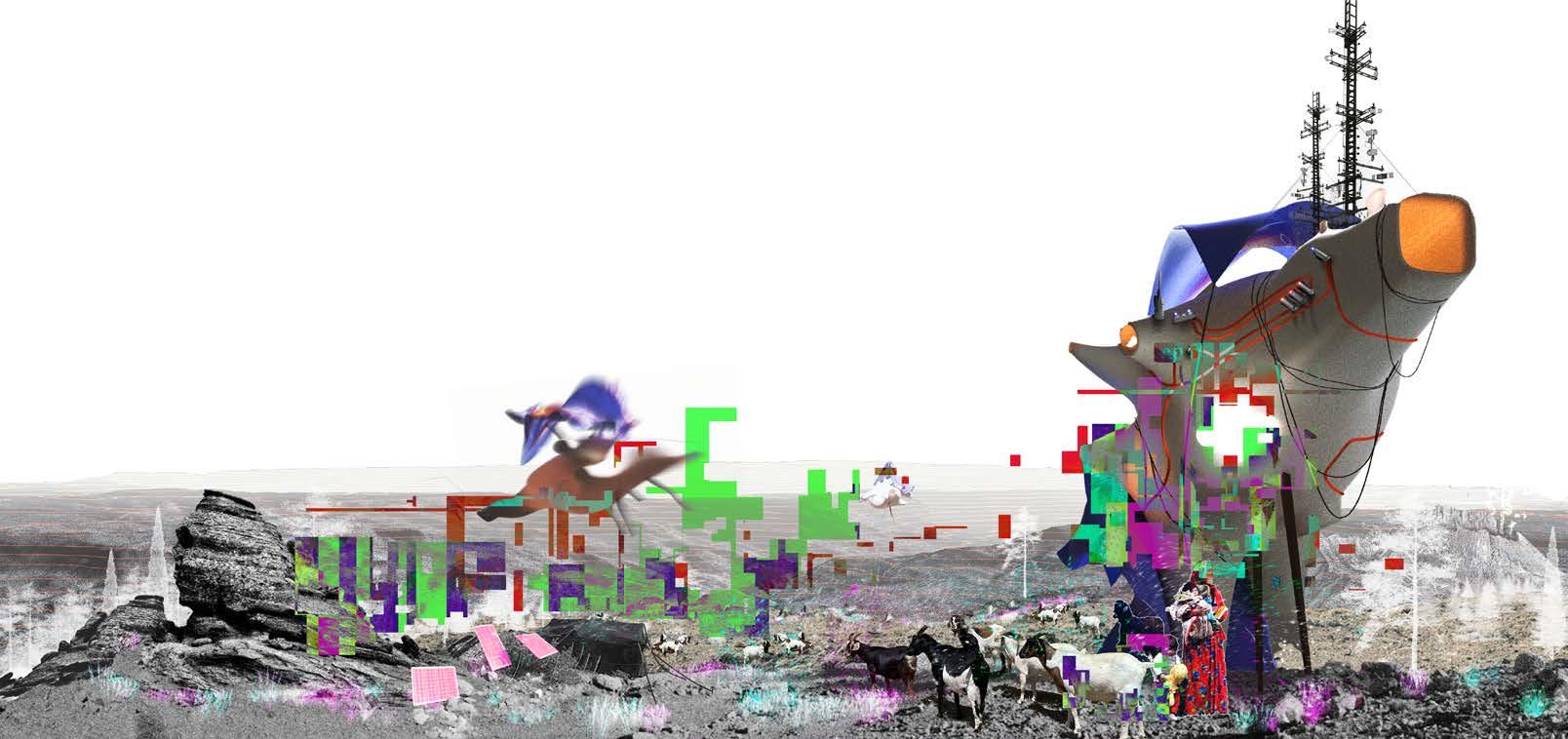

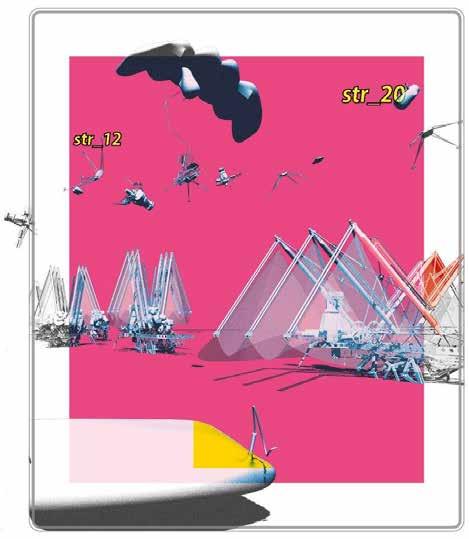
vector. Heraclitus instead of Parmenides: the manifest
Another part developed in a more sociological framework. I tried to create my discourse by reading about the duality of the rural City and the rural nature, and confronting the social crumbs of the holistic View and the unchanging, fixed Aristotelian understanding of the universe. When we take a look at today's rural areas, including the Taurus Mountains, we can see that the archaic and the ultra-modern coexist. (Lefebvre) This destroys the perception that development is continuous and chronologically continuous and linear. This rather absurd, "queer" landscape, on the other hand, calls into question the understanding of a whole and continuous, somewhat static universe, which has a kind of purpose of existence.

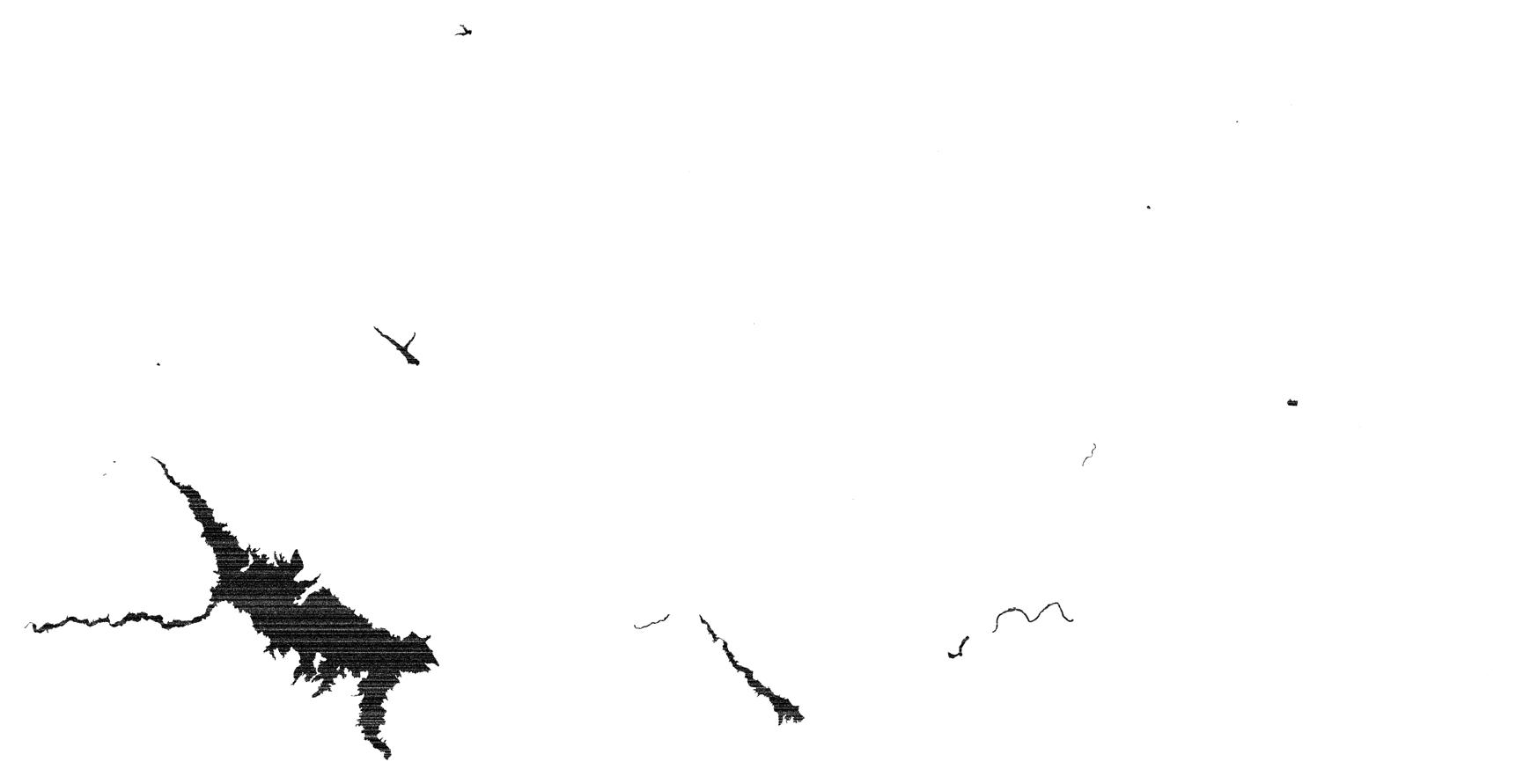





program:particles
The intervention consists of particles that move and change Phase according to certain changes in the region, and topomorphers that shape the topography. Moving particles are formed by the combination of components of various qualities in different ways. Particles; detect properties such as temperature, humidity, pressure, and sunlight both physically and electronically and determine their motion and phase. This causes annual, monthly, and instantaneous rhythms that are Close to cyclical. Phase and position shifting is somewhat simultaneous with the rhythms of other actors in the topography.
program: different scales on time
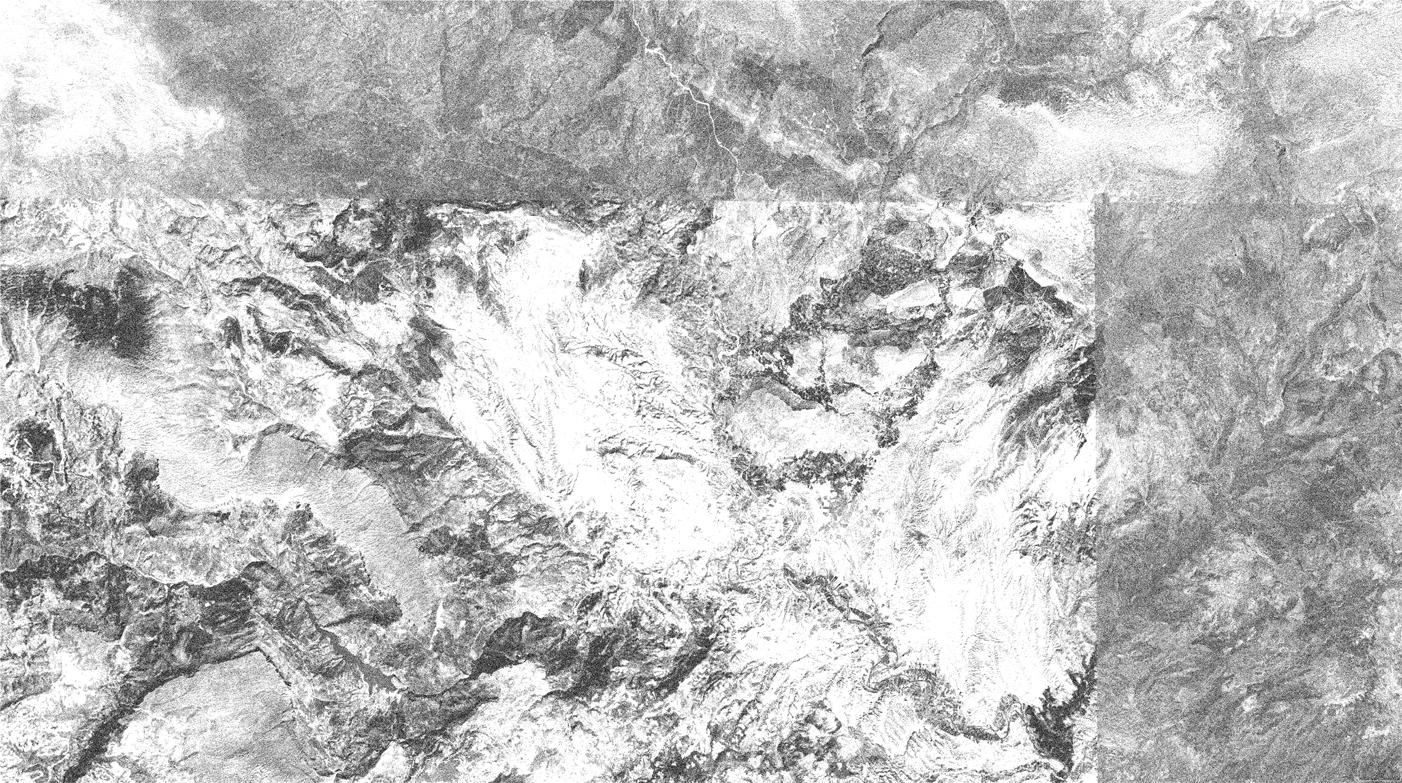


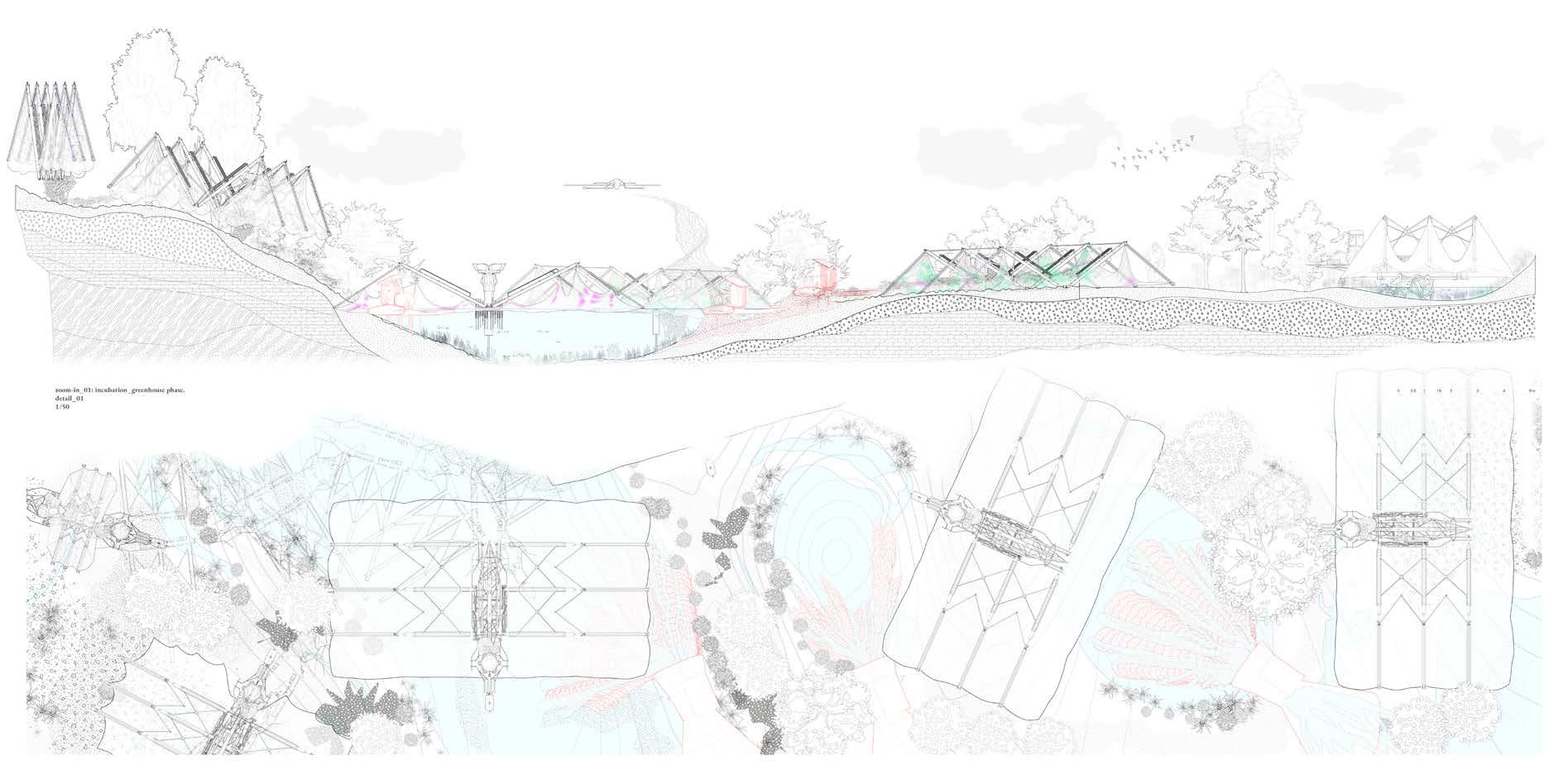
It provides opportunities for new relationships
and diverse ecological systems. As the moving particles change place and shape, the existing relationships and systems darken each other.
Fixed particles shape all thermodynamic fields, and therefore systems and relationships, by forming topography. These two-leg mixing actions act on various temporal scales ranging from microscopic moments to centuries.
00 incubation period
The mobile particles settle in the shallow and reedy parts of the creek, next to the "topomorphers" in wide mode. In contrast to the cold climate of winter, it forms a short-lived biome with "topomorphers" Chat shape the topography by heating the water. Various bryophytes, grass-bodied plants, and amphibians inhabit this biome.
01 from the incubation period to becoming a transporter vector
When the threshold humidity and temperature values are reached in the climate of the region, the triggers activate the moving particles. Particles begin their movement, which tends to raise altitude so that they can meet Nomadic groups on the track.
topomorpher
The riparian topomorpher, which has 2 forms, riparian and plateau, heats and compresses the river water and then releases it back into the river, allowing calcium carbonate to precipitate in the water. This process travertines the region and in a way shapes the topography. Thus, it can hack one of the fundamental layers of thermodynamic movements in the region and thus all other processes in the upper layers.
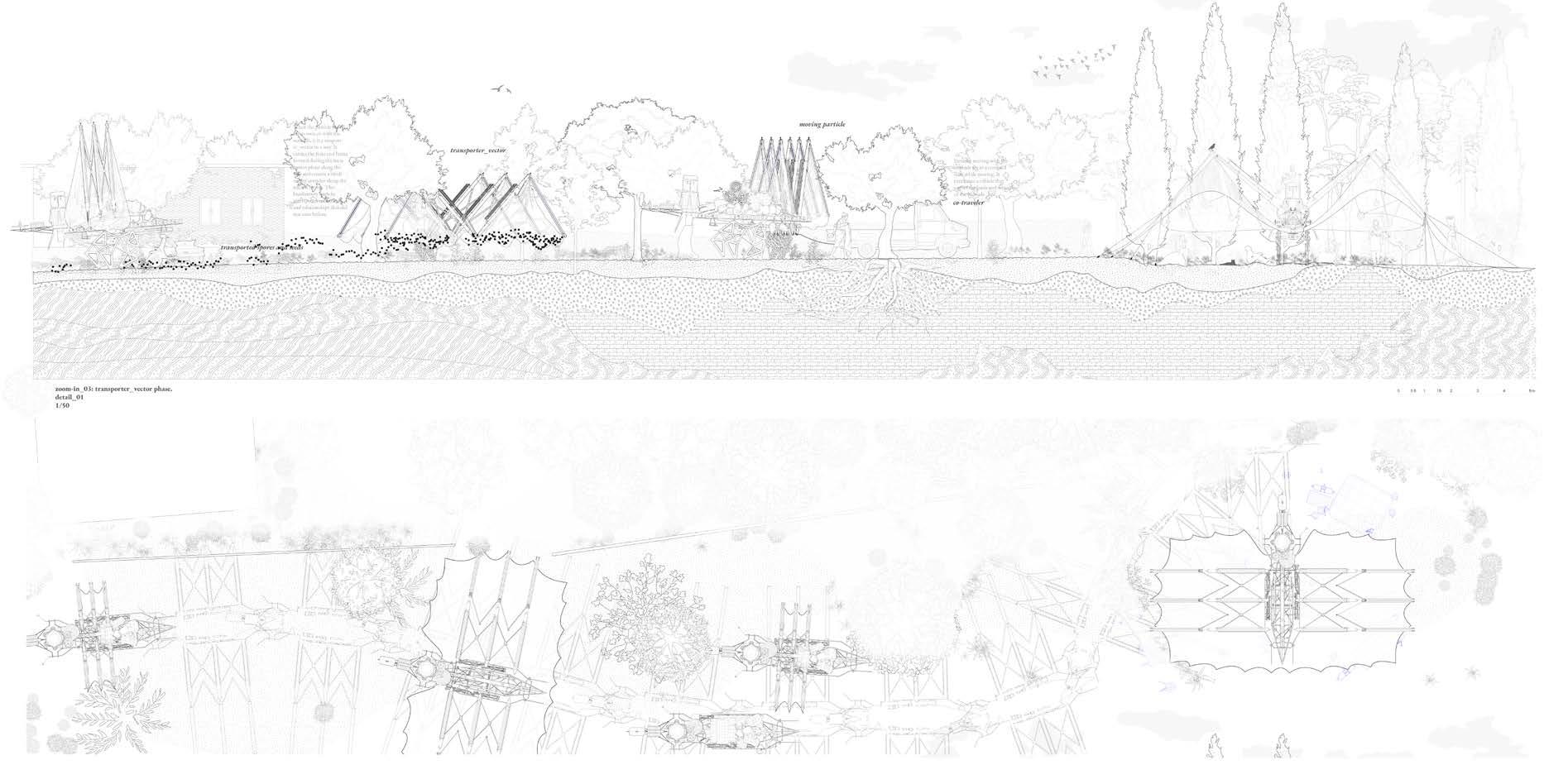


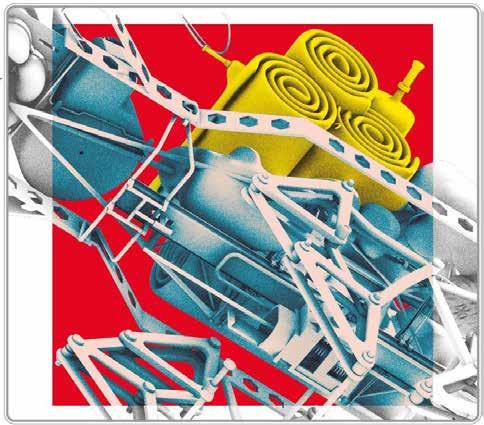
prtcl_01 : transporter vector
In a combination where the components are like this; in general, there is a tarpaulin mechanism that can compact and expand, which has the potential to create habitats, a turbine-generator-spring mechanism that can store both electrical and mechanical energy with Wind and wave energy, a receiver set that can receive signals from "communicator particles" outside and other sensors in the environment, and a movement mechanism that moves with mechanical energy in the mainspring. The tarp itself contains a mesh of sensors and radiator components. In addition, some bags collect the water from the stream during the incubation-greenhouse period and carry the microflora in the "transporter vector" process, which the nomads can remove and use for various storage purposes in the highlands.
prtcl_02: communicator
In this particle combination, there are more compact and lighter turbines, sensors that sense the environment, and helium tubes that feed the helium balloon that Will keep it moving at certain periods.


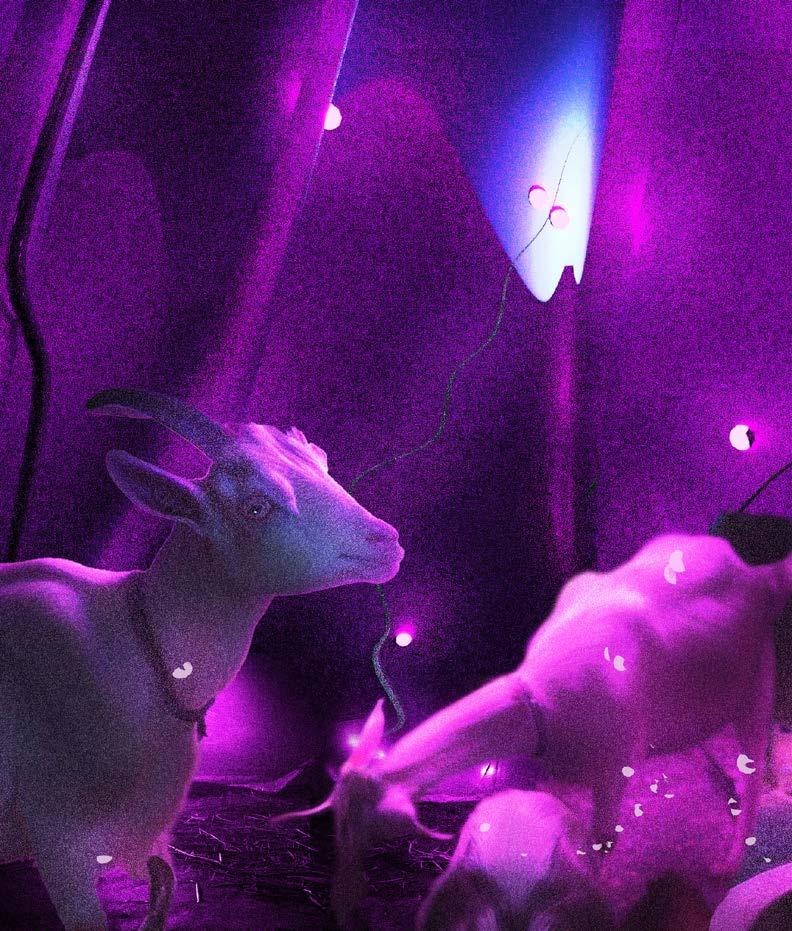
When the conditions are met, the particles may not return to the regions where they Will enter the incubation-greenhouse period and may remain in the middle of the road. Maybe this "stay on the road" situation can last until it is found by a moving nomadic group or a villager. At that time, the particle Will create a different climate between the tarpaulin "and the ground than the outside environment and Will attract guests who love this climate.
While the bottom of the tarpaulin creates a different microclimate due to the nature of the material, it provides different possibilities for the floral subjects it can carry. With the sensor and radiator (UV) components on the tarpaulin, it enables the development of floral subjects that normally need more daylight. This is a kind of hacking of the ecological niche. The bags on the tarpaulin, on the other hand, also lead to the presence of bryophytes that can be found in water in areas where they are not normally expected.
The relationship between the ground and the tarpaulin can provide a shelter for goats or nomads, as well as allowing the floral diversity to live in unexpected geographies. In this state, while we see the most compact and controlling the state of the particles, we can also witness the dissolution of the particle (on the left) that is not used by a human user and lost its cyclical motion-energy balance and is stuck on the path.

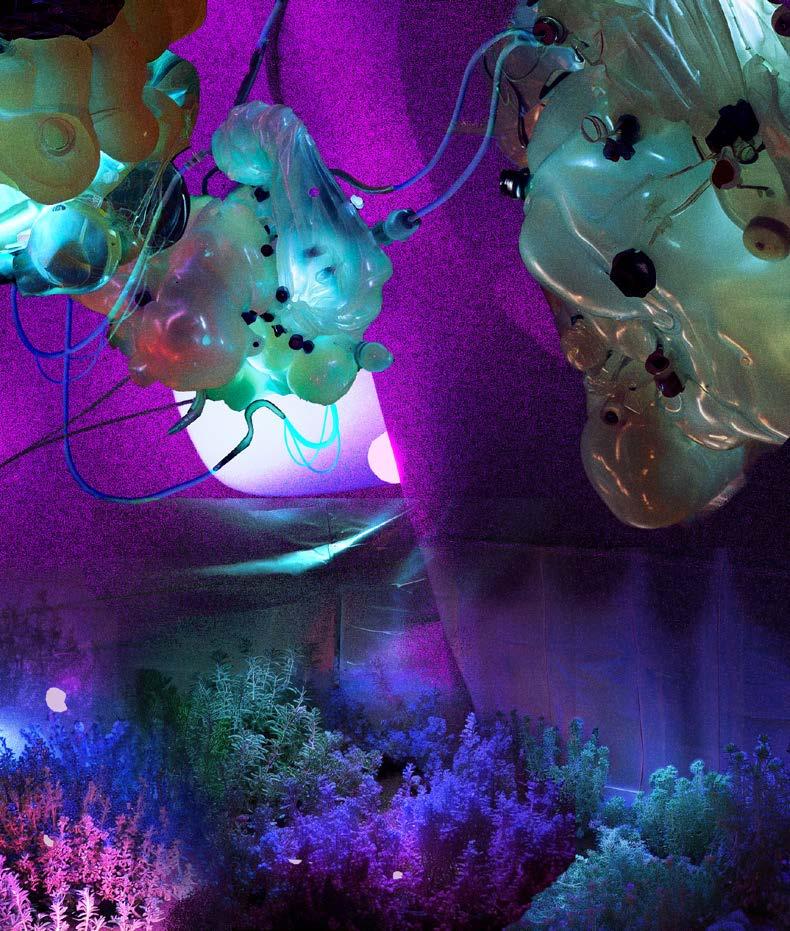

ENG
what is human
re-creation of transhuman
Housing states of hybrid humans in a volume that moves within mechanical and morphogenetic forces.
Is it just a carbon-based pile of organic matter called "Homo sapiens in the primate order" that can interact with the external environment, or do we attribute this definition to all material and non-material "things" that can manipulate their environment to their advantage and have intelligence and consciousness?
TUR insan nedir
“Primat takımındaki Homo sapiens” adlı karbon bazlı, dış çevreyle etkileşime girebilen organik madde yığınından ibaret midir, yoksa çevresini kendi çıkarına göre manipüle edebilen, zekaya ve bilince sahip tüm materyal ve materyal olmayan “şey”lere bu tanımı mı atfederiz?

LEFT
Accumulations, concentrations and erosions in Foça Caldera and Gediz Delta
Human being is a hybrid (cyborg) in terms of existence. The basic qualities of his /her existence and all that can be considered as phenotype are the environment he manipulates, again thanks to the tools he manipulates and uses according to his various qualities. What a mole's claws, a bear's teeth, a bull's horns are to man, tools have become the extension of his mind and limbs. Man cannot be fully defined by ignoring the tools he uses, the abstract social structures s/he creates, and the built environment s/he builds.
So, how accurate is it to define "man" clearly as a body that is perceived as truly holistic and individual, with organic boundaries? (orbital-probability density cloud)
If a human consists of an organic body, where in the range of an artificial intelligence that can empathize with a "human" with an artificial organ (prosthesis) does the definition of "human" go beyond? Or future hybrids of artificial-intelligence and human intelligence, disembodied human, virtual existence, CRISPR-modified superhumans. .
İnsan varoluşu itibariyle bir hibrittir (siborg). Varoluşunun temel nitelikleri ve fenotipi sayılabilecek bütün manipüle ettiği çevre, yine çeşitli niteliklerine göre manipüle edip kullandığı aletler sayesindedir. Köstebeğin pençeleri, ayının dişleri, boğanın boynuzları ne ise insan için de araçlar zihninin ve uzuvlarının uzamı olmuştur. İnsan kullandığı aletler, yarattığı soyut sosyal yapılar ve inşa ettiği yapılı çevre göz ardı edilerek insan tam anlamıyla tanımlanamaz.
O halde "insanın" gerçekten bütünsel ve birey olarak algılanan, sınırları organik bir beden olarak net bir şekilde tanımlanması ne kadar doğrudur? (orbital-olasılık yoğunluk bulutu)
Eğer insan organik bir bedenden ibaretse yapay organlı (protezli) bir "insan" ile empati yapabilen bir yapay zekâ aralığının neresinde "insan" tanımının dışına çıkılıyor? Ya da gelecekte yapay-zekâ ve insan zekâsı hibritleri, bedensiz insan, sanal varoluş, CRISPR ile genetiği değiştirilmiş süperinsanlar. . .
beden organizma elma at buğday köpek koyun öküz simbiyoz taş kalem protez/arayüz çekiç balta ev kültür devlet hukukisistemler ekonomik sistemler internet blockchain artırılmış gerçeklik (AR) sanal gerçeklik(VR) metaverse gelenek köy kent posta/haberleşmeağları sosyalilişkiağları altyapı alan kağıt değirmen ok/yay vinç makine araba protez daktilo otomat bilgisayar kulaklık yapay zeka neuralink CRISPR telefon s i borg soyu t s o sy a y a p ı l a r çözükinsan kent etkileri doğal etkenler İnsan insan


If the origin of the construction and destruction it has created throughout its existence is actually a quality found in all organisms, what would be the reason for separating it from other living things when thinking about the being defined as "human"?
Feedback loops depending on simple variables in the universe, likewise dependence on algorithms based on very basic variables, can create forms, movements and phenomena, behind the creation of which we can almost look for consciousness.
Is there, then, a clear distinction between life and nonlife as we perceive it?
Varoluşu boyunca yarattığı yapım ve yıkımın kökeni aslında bütün organizmalarda bulunan bir nitelikse, "insan" diye tanımlanan varlık hakkında düşünürken diğer canlılardan ayrı tutmamızın gerekçesi ne olacaktır?
Evrende basit değişkenlere bağlı geri beslemeli döngüler, yine aynı şekilde çok temel değişkenleri baz alan algoritmalara bağlı oluşlar, yaratılışının arkasında neredeyse bir bilinç arayabileceğimiz biçim, hareket ve olguları yaratabilirler.
O halde algıladığımız gibi canlılık ve cansızlık arasında net bir ayrım var mıdır?Canlılık da herhangi bir karmaşık sistemden veya geri beslemeli sistemler yumağından mı
hibrit
siborg
biyoorganik
İnsan ale kullanan insan
insan-hesap mak. birl.
insan- öpek birl.
insan-at birl. insan-otomobil birl.
bilgisayar
insan-yapay zeka birl. insan-yapa zeka hibridi (hibrit zek )
sanal ge çeklik gözlüğü beyin çipi
insan min. arayüz)
protezli insan “siborg” yapay zeka
yapay organlı insan
organ nakilli insan
genetiği iyileştirilmiş insan genetiği “geliştirilmiş” insan
bedensiz insan
insan-dışı (?) nitelikli
insan-dışı (?) nitelikli organizma
Does life consist of any complex system or a ball of feedback systems?
Or can they be perceived as "living" by going beyond some biological definitions?
The human body, the state of being an individual, its definition and scope become ambiguous; Where should architecture find its meaning in the universe of homo sapiens, mammals, animals, micro-macroorganisms, inorganicity, relations, formations, systems, mechanisms and chaos moving together in which concepts dissolve into each other?
ibarettir?
Ya da bunlar bazı biyolojik tanımlamalar dışına çıkılarak birer “canlı” olarak algılanabilir mi? İnsanın bedeninin, birey olma hâlinin, tanımının ve kapsamının muğlaklaştığı; Homo sapiens’in, Memelilerin, hayvanların, mikro makroorganizmaların, inorganikliğin, kavramların birbiri içine çözüldüğü ilişkiler, oluşlar, sistemler, mekanizmalar ve kaosların bir aradalığıyla devinen yumaklar evreninde mimarlık nerede anlamını bulmalıdır?
Where to find the definition of the act of "dwelling" in such a cosmos?
Is the product of architecture a "shell" that provides the usual meaning, form and functions? Or is it the fields defined by an "infrastructure" provided/provided by relations, systems and flows, and the "opportunities" created by these fields?
Böyle bir kozmosta “barınma” eylemi tanımını nerede bulmalıdır?
Mimarlığın ürünü, alışılageldik anlam, biçim ve fonksiyonları sağlayan bir “kabuk” mudur? Yoksa ilişkilerin, sistemlerin ve akışların sağladığı/sağlandığı bir “altyapı” ile tariflenen alanların ve bu alanların yarattığı “imkanlar” mıdır?
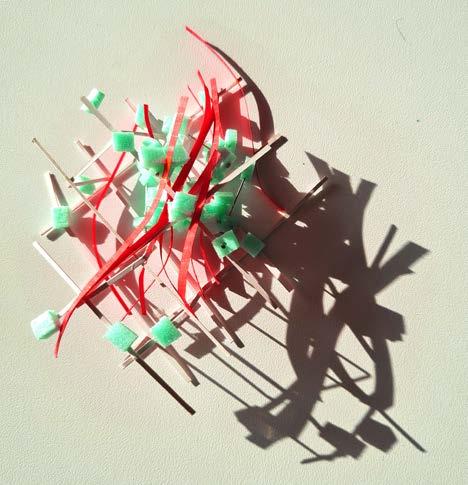
In this proposal the shelter of the posthuman and the nonhuman was explored. An architecture that defines itself through networks of relationships, geophysical and meteorological mechanisms, micro and macro organic rhythms and ecological systems in all aforementioned different scales and layers, oscillating between morphogenetic and mechanical effects and reshaping itself autonomously by constantly constructing and destroying itself, is proposed. possibilities are explored.
Bu öneride sonraki-insanın ve insandışının barınması araştırıldı. Tüm bahsi geçen farklı ölçek ve katmanlardaki ilişki ağları, jeofizik ve meteorolojik mekanizmalar, mikro ve makro organik ritimler ve ekolojik sistemler üzerinden kendini tanımlayan, morfogenetik ve mekanik etkilerin arasında gidip gelen ve otonom olarak sürekli kendini yaparak ve yıkarak yeniden biçimlendiren bir mimarlık önerilmekte ve bu mimarlığın imkanları araştırılmaktadır.



Place-making/space-defining actors
The microclimate, which is formed specifically around Foça and shaped by the effects starting from macro scales, shapes both the topography and the density, distribution and movement patterns and textures created by the organisms in the region. The proposal defines these mechanical effects as input parameters for the space-builder algorithm and recreates the space-shaping nature of these systems in a cybernetic layer. Now the elements that define the space are systems, flows and the spaces they create.
One of the factors that define the sheltering tissues of the piles of organisms, the "humidity field " intervention is made to be manipulated within the scope of the proposal. The "attractor" poles that spread over the area, spray atomized water vapor at various intensities, defining new patterns of organism dispersal and possibilities. This defined humid area becomes dynamic by coinciding with the microclimatic areas of Foça. The direction of the wind vector, its intensity and the obstacles created by the topography and the intensities that appear create certain opportunity gradients.
Mekân kurucu/alan tanımlayıcı aktörler
“Foça Kalderası ve Gediz Havzasını biçimlendiren mikroklimatik ve jeofizik sistemler ve sistemlerin sibernetikleşmesi.” Foça çevresine özel olarak oluşan ve makro ölçeklerden başlayan etkilerin biçimlendirdiği mikroklima, hem topografyayı hem de organizmaların bölgede yarattığı yoğunluk, dağılım ve hareket örüntü ve dokularını biçimlendirmektedir. Öneri, bu mekanik etkileri mekân kurucu algoritması için girdi parametreler olarak tanımlayarak bu sistemlerin mekânı biçimlendirme niteliğini sibernetik bir katmanda yeniden oluşturur.
Organizma yığınlarının barınma dokularını tanımlayan etkenlerden biri olan “nem alan” müdahale dahilinde öneri dahilinde manipüle edilebilir hale getiriliyor. Alana yayılan “atraktör” direkler, çeşitli yoğunluklarda atomize su buharı püskürterek yeni organizma yayılım patternleri ve imkanları tanımlıyor. Bu tanımlanan nem alan Foça’nın mikroklimatik alanlarıyla çakışarak dinamik bir hal alıyor. Rüzgâr vektörünün yönü, şiddeti ve topografyanın yarattığı engeller ile beliren yoğunluklar belli imkan gradyanları oluşturuyor.




attr.xx atraktör yoğuşmayla veya atomize su buharıyla nem alan yaratır.
rcpt.xx reseptör Alanı algılayarak atraktörleri, mekan kurucu ajanları yönlendirir, hibrit insanın duyu uzantısına dönüşür



"
Ajan olarak tanımlanan ve mekanın inşasını belirleyen, alandaki değişkenlere bağlı bir algoritmaya bağlı sanal parçacıklar, hacmi tüfle güçlendirilmiş biyoçimento ile “yazacak” robotları yönlendirerek mekanı sürekli üretmektedir. Bu üretim, alanın belirli bölgelerinde yoğunluğu değişen hacmi oluşturmaktadır. Hacmin materyalnitelikleri; mikroklimatik etkileri, enerji akışlarını (ışı, ışık, hareket -dolayısıyla kütle-) sönümleyerek ve nem alanla birleşerek alan tariflerini çeşitlendirmektedir. Açıklık-kapalılık ikiliği ise tanımların kapsamlarının geçişken olduğu bir gradyana dönüşmektedir. Eylem ve imkanlar ise bu dinamik ve kesişip duran yoğunluk bulutları içinde var olmaktadır. Tanımı gibi hayvansal zekâsı da yapay zekâ
ve Web içinde çözülmüş insanın mekân deneyimi de bedeninin sınırları içinde (perspektif) kalmayacaktır. Hayvansal bedeninin imknaları sınırlarında algıladığı duyular haricinde, bedenin sınırlarını ve imkanlarını aşan duyu ve algı aralığı, uzamdan bağımsız sistemler içinde çözünen bir siborg için kaçınılmaz olacaktır. Mekândan giderek bağımsızlaşan sistemler içinde kendi de bu bağımsızlığa katılan hibrit insan, yerküre üzerinde biyolojik kütlesini geçimişin rotalarının izdüşümünde aylakça dolaştırırken homeostasisi devam ettirebileceği duraklarda barınır. Bunlar biri olan bu projede ise homeostasisi sağlayan beden uzantıları kapsüllerdir. Alanda barınma halinin organik beden için en pasif, hibrit insanın algıları için ise en çeşitli olduğu kısım kapsüllerdedir.
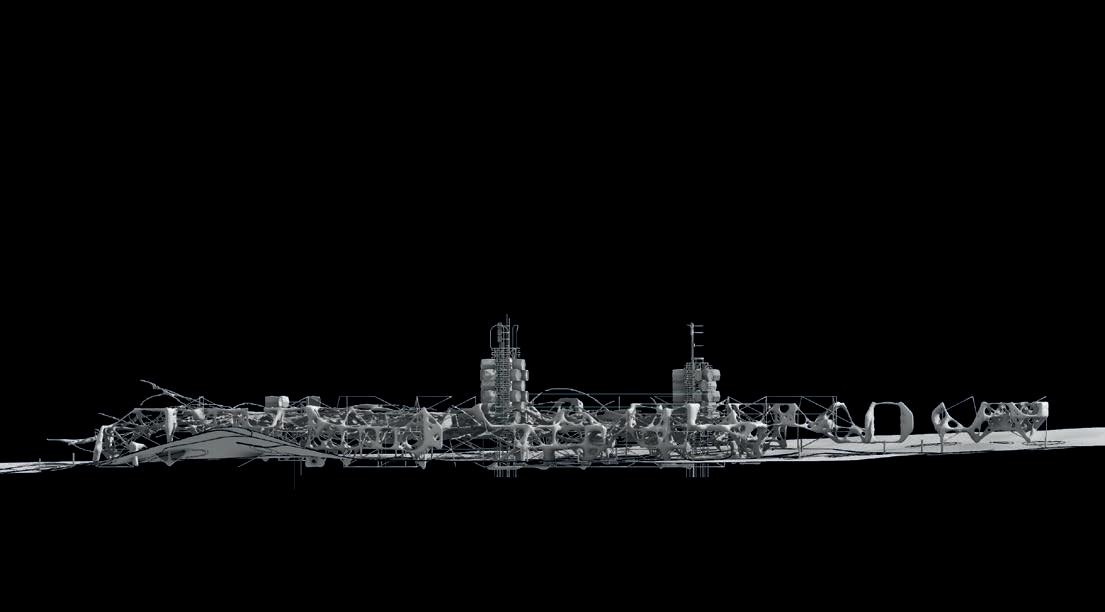
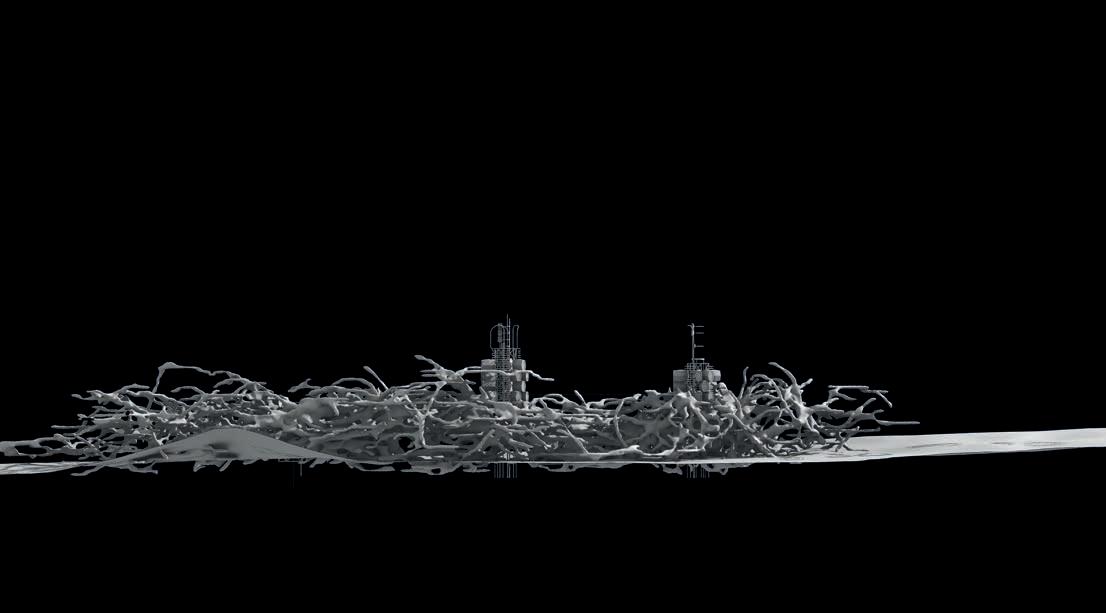
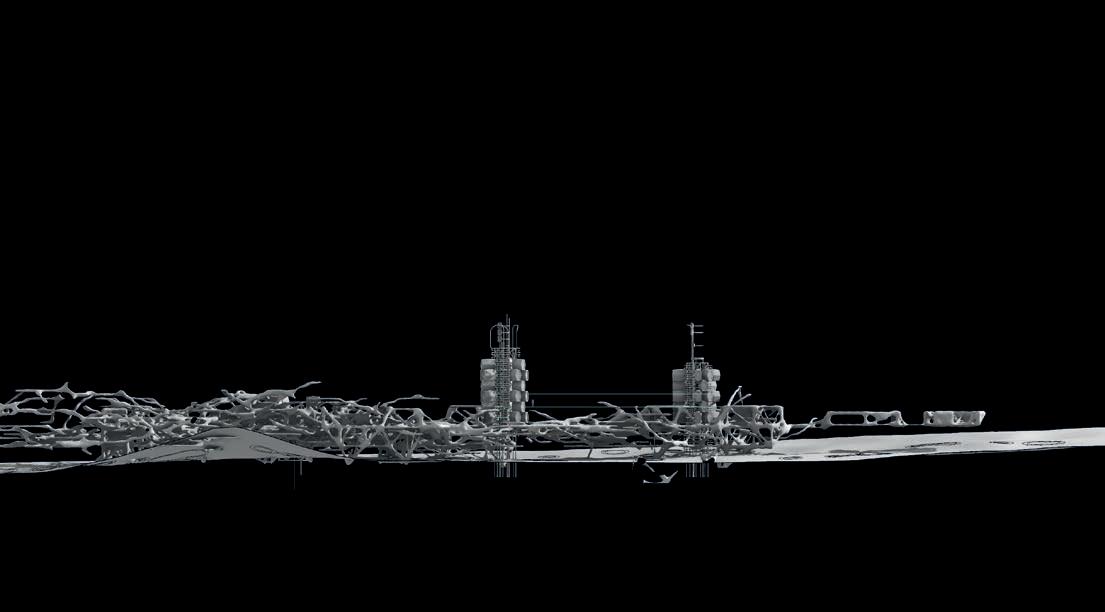


Porosity
Virtual particles, defined as agents and connected to an algorithm depending on the variables in the field, which determine the construction of the space, continuously produce the space by directing the robots whose volume will "write" with biocement reinforced with tuff. This production creates a volume of varying density in certain parts of the area. Material qualities of the volume; Microclimatic effects diversify the definitions of space by damping energy flows (light, light, motion -and hence mass-) and by combining moisture with the field. The openness-closeness duality, on the other hand, turns into a gradient in which the scopes of the definitions are transitive.
The spatial experience of humans, whose animal intelligence is dissolved in artificial intelligence and the Web, will not remain within the limits of their body (perspective). Except for the senses that he perceives within the limits of his animal body's possibilities, the range of senses and perceptions that exceed the limits and possibilities of the body will be inevitable for a cyborg that dissolves in systems independent of space. Hybrid human, which participates in this independence within the systems that are becoming more and more independent from the space, shelters in the stops where it can maintain homeostasis while loitering its biological mass in the projection of the routes of the past. In this project, which is one of them, body extensions that provide homeostasis are capsules. The most passive for the organic body, and the most diverse for the perceptions of the hybrid human, is in the capsules.
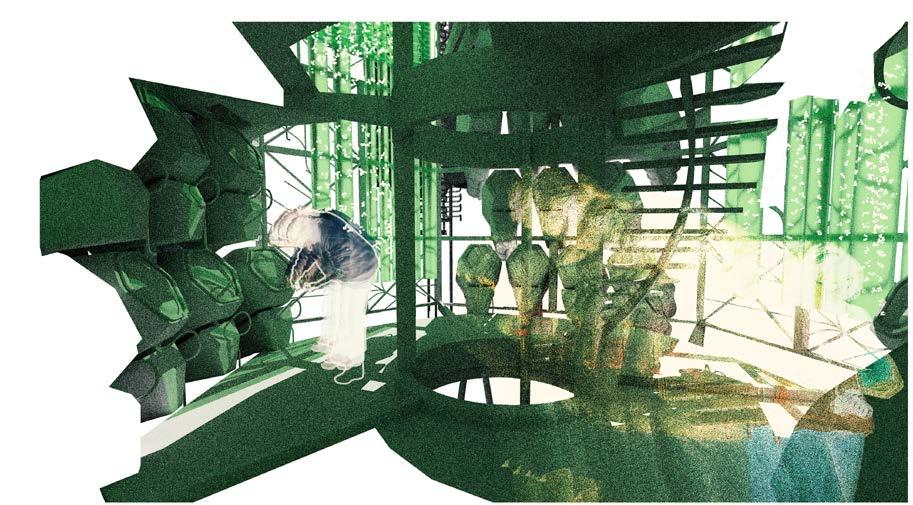
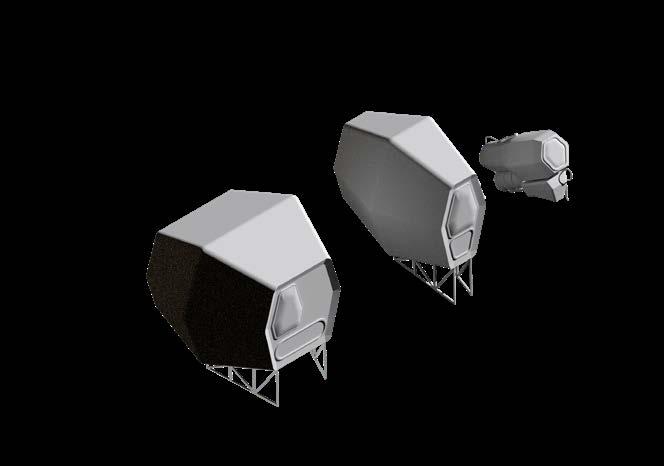

in-situ institutes
archaeo-industrial promenade in the old Orient Express railway
MimED 2022 - Project Awards for Architecture Students, 3rd year category/1st Prize
The Sirkeci-Halkalı railway line, which has been idle since the opening of Marmaray in 2013, has gained an important place in the memory of the society since its construction. Its idle state for nearly 10 years is undoubtedly another form of space in the community’s memory.
An archaeo-industrial promenade where one can experience the “terrain vague” space on the Sirkeci-Halkalı railway line at the scale of Masterplan, based on the spatial value and atmospheric
character that the place acquired as a result of its current state of being out of urban systems and losing its use, was proposed. In addition to the strong relationship of the railway line with the archaeological sites as a result of its relationship with the city wall, the importance of the railway line itself in the industrial and transportation history of Istanbul supports this proposal.
2013 yılında Marmaray’ın açıldığı tarihten itibaren atıl bırakılan Sirkeci-Halkalı demiryolu hattı, yapıldığı dönemden itibaren toplum hafızasına önemli bir yer edinmiştir. 10 yıla yakınki atıl hali de, şüphesiz, mekanın toplum hafızasındaki başka bir biçimidir. Mekanın mevcut halinin kentsel sistemlerin dışına çıkıp kullanımını yitirmesi sonucu edindiği mekansal değerin ve atmosferik karakterinde korunmaya değer bir nitelik olmasından yola çıkılarak Masterplan
ölçeğinde Sirkeci-Halkalı demiryolu hattı üzerinde “terrain vague” mekanın deneyimlenebildiği bir arkeo-endüstriyel promenad önerildi. Demiryolu hattının sur ile ilişkisi sonucu arkeolojik alanlarla ilişkisinin güçlü olmasının yanısıra demiryolu hattının kendisinin İstanbul’un endüstri ve ulaşım tarihindeki önemi bu öneriyi desteklemektedir
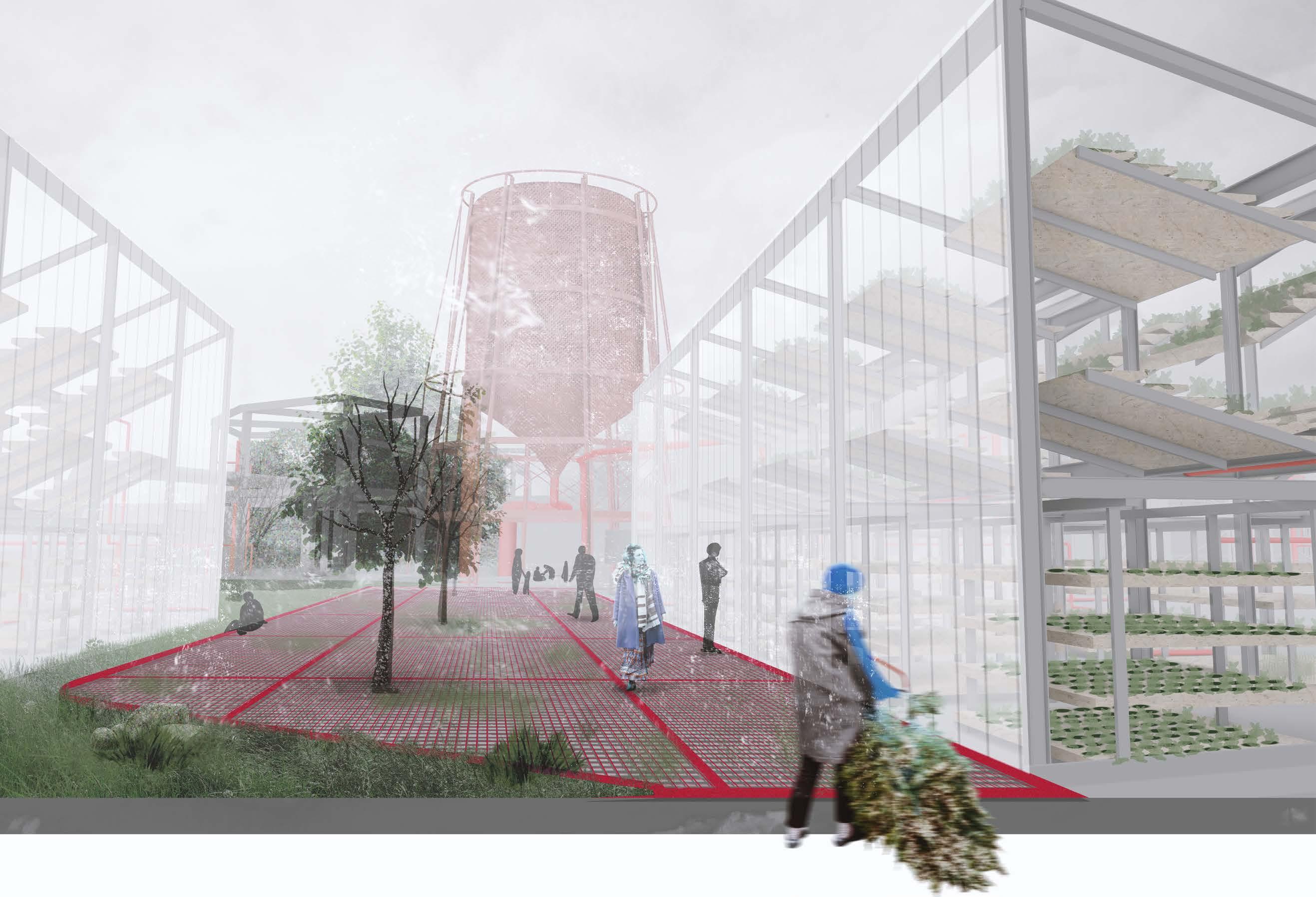

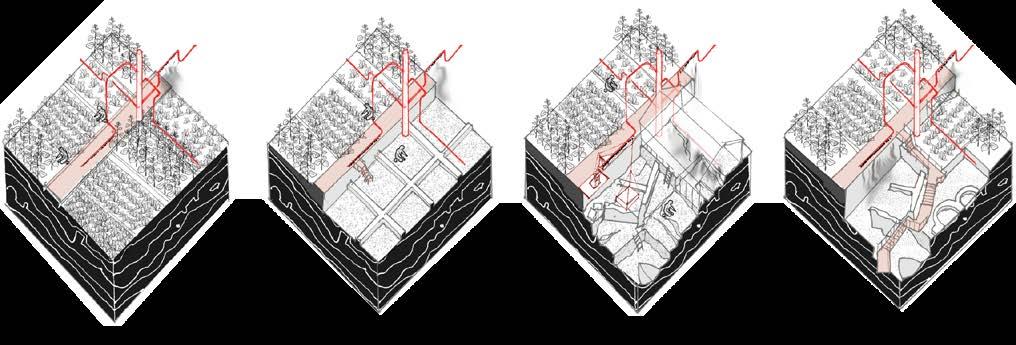
in-situ institutes is located at the location of “Emniyet International Terminal and Langa Industrial Site, which was still used as a garden until 2006, but today. The intervention proposal consists of the bostans used by the residents of the area used as the terminal, archaeological excavation sites and a promenade where the layering emphasized by this duality is experienced. This promenade is an extension of the main promenade at the scale of the Historic Peninsula.Industrial structures that have increased gradually in the last 70 years in the region and the reinforced concrete walls of the terminal built in the last 10 years are not seen as less valuable than any change that the region has gone through, and design decisions are tried to be made by qualifying them as worthy of protection.
The two focal towers on the route physically emphasize the program of intervention in the region. The irrigation system, which irrigates the orchards and keeps the humidity of the newly uncovered archaeological find constant, is fed from the water tower. Archaeological finds are moved to the archive tower to be researched and preserved. Due to the potential they have, these two towers gather public programs around them.
in-situ institues, 2006 yılına kadar hala bostan olarak kullanılan ancak günümüzde “Emniyet Uluslararası Terminali ve Langa Sanayi Sitesinin bulunduğu konuma yerleşmektedir. Müdahale önerisi, terminal olarak kullanılan alanın çevre sakinleri tarafından kullanılan bostanlara, arkeolojik kazı alanlarına ve bu ikiliğin vurguladığı katmanlılığın deneyimlendiği bir promenaddan oluşmaktadır. Bu promenad, Tarihi Yarımada ölçeğindeki ana promenadın bir uzantısıdır. Bölgede son 70 yılda kademeli bir şekilde artan sanayi yapıları ve son 10 yılda inşa edilen terminalin betonarme duvarları bölgenin geçirdiği herhangi bir değişimden daha az değerli görülmeyip korunmaya değer nitelendirilerek tasarım kararları verilmeye çalışılmıştır. Rotanın üzerinde bulunan ve odak noktası sayılan iki kule bölgedeki müdahalenin programını fiziksel olarak vurgular. Bostanları sulayan ve yeni yüzeye çıkan arkeolojik buluntunun nemini sabit tutmaya yarayan sulama sistemi su kulesinden beslenir. Arkeolojik buluntuların araştırılmak ve korunmak üzere arşiv kulesine taşınır. Bu iki kule, sahip oldukları potansiyel sebebiyle kamusal nitelikli programları çevresinde toplar.


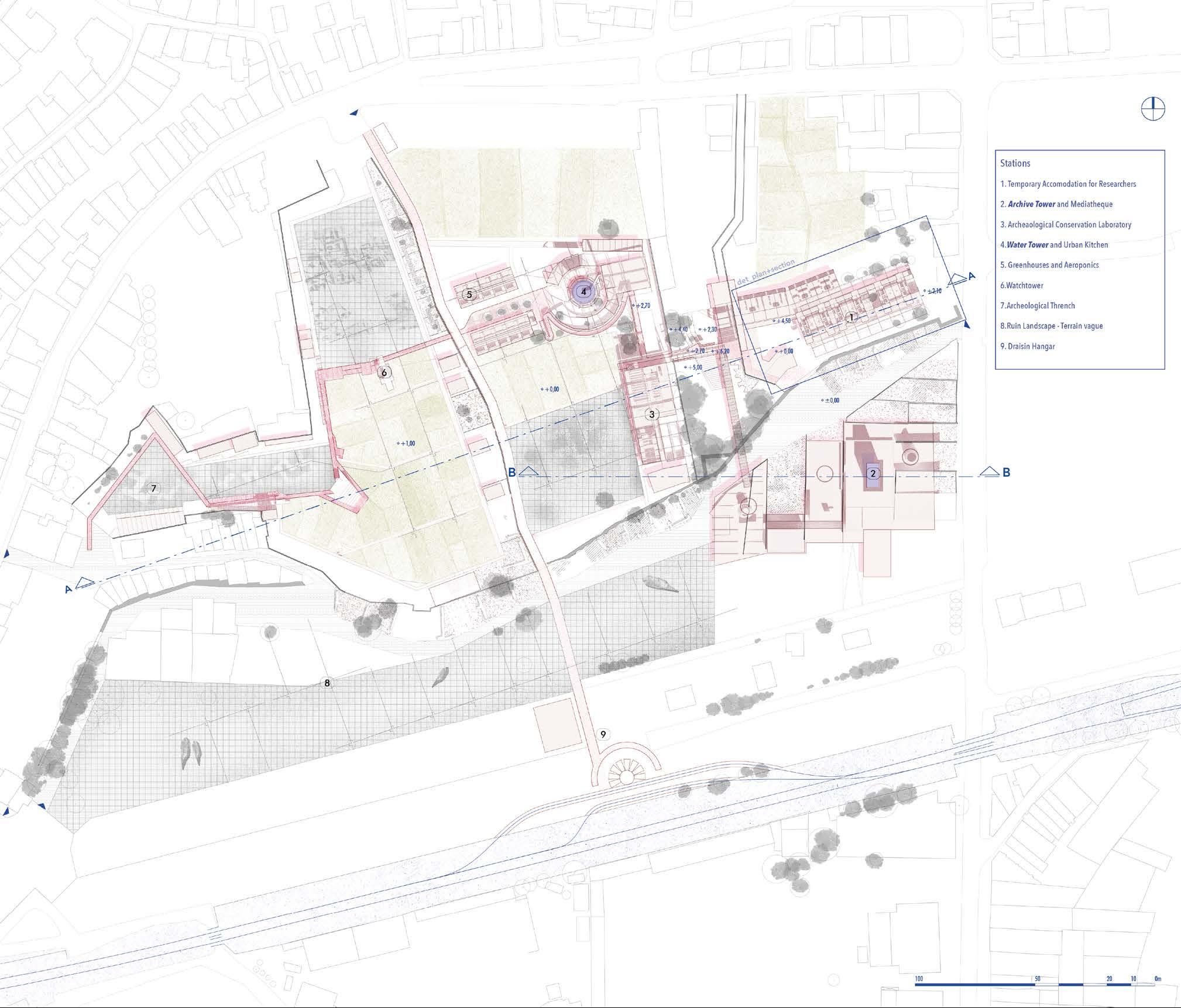
the water tower/urban kitchen
The water tower is located at the center of the irrigation infrastructure that feeds all of the orchards and acts as the heart of the garden. The emphasis on the water tower feeding the garden is strengthened by the revealing of the water pipes radiating from the water tower to the orchards. The nurturing water tower image takes on a second meaning as it also hosts the kitchen program where the produce from the garden is processed and eaten. “The water tower that feeds the garden and the garden that feeds the people.”
The urban kitchen program also creates indoor and outdoor public spaces
the archive tower
The archive tower is a structure where the finds obtained in the archaeological trenches are collected and preserved. being located in the center of the library, it forms the narrative of “the pure source of information at the heart of the space and the various media surrounding and produced by the processing of this pure information”.
archaeological trench
Archaeological trenches opened in some parts of the area reveal the layered nature of the region. The settlement of the garden at the bottom of the archaeological excavation area and the transformation of the existing pit after the completion of the archaeological excavations emphasizes that this layering continues in life.
su kulesi/kentsel mutfak
Su kulesi, bostanların tümünü besleyen sulama altyapısının merkezinde bulunup adeta bostanın kalbi görevi görüyor. Bostanı besleyen su kulesi vurgusu, su kulesinden bostanlara yayılan su borularının ortaya çıkarılmasıyla güçleniyor. Besleyici su kulesi imgesi, bostandan elde edilen mahsüllerin işlendiği ve yendiği mutfak programına da ev sahipliği yapmasıyla ikinci bir anlam kazanıyor. “Bostanı besleyen su kulesi ve insanı besleyen bostan.”
Kentsel mutfak programı aynı zamanda kapalı ve açık kamusal alanlar yaratıyor. arşiv kulesi
Arşiv kulesi, arkeolojik açmalarda elde edilen buluntuların toplandığı ve korunduğu bir strüktür. Medyatekin merkezinde yer almasıyla “bilgi mekanının kalbinde yer alan saf bilgi ve bu saf bilginin işlenmesiyle üretilen ve çevresini saran çeşitli medyalar” anlatısını oluşturuyor.
arkeolojik açmalar
Alanın bazı bölgelerinde açılan arkeolojik açmalar bölgenin katmanlı niteliğini ortaya çıkarıyor. Arkeolojik kazı alanının dibinde bostanın yerleşmesi ve arkeolojik kazıların tamamlanmasından sonra da mevcut çukurun bostanlaşması bu katmanlılığın yaşantı içinde de sürdüğünü vurguluyor.

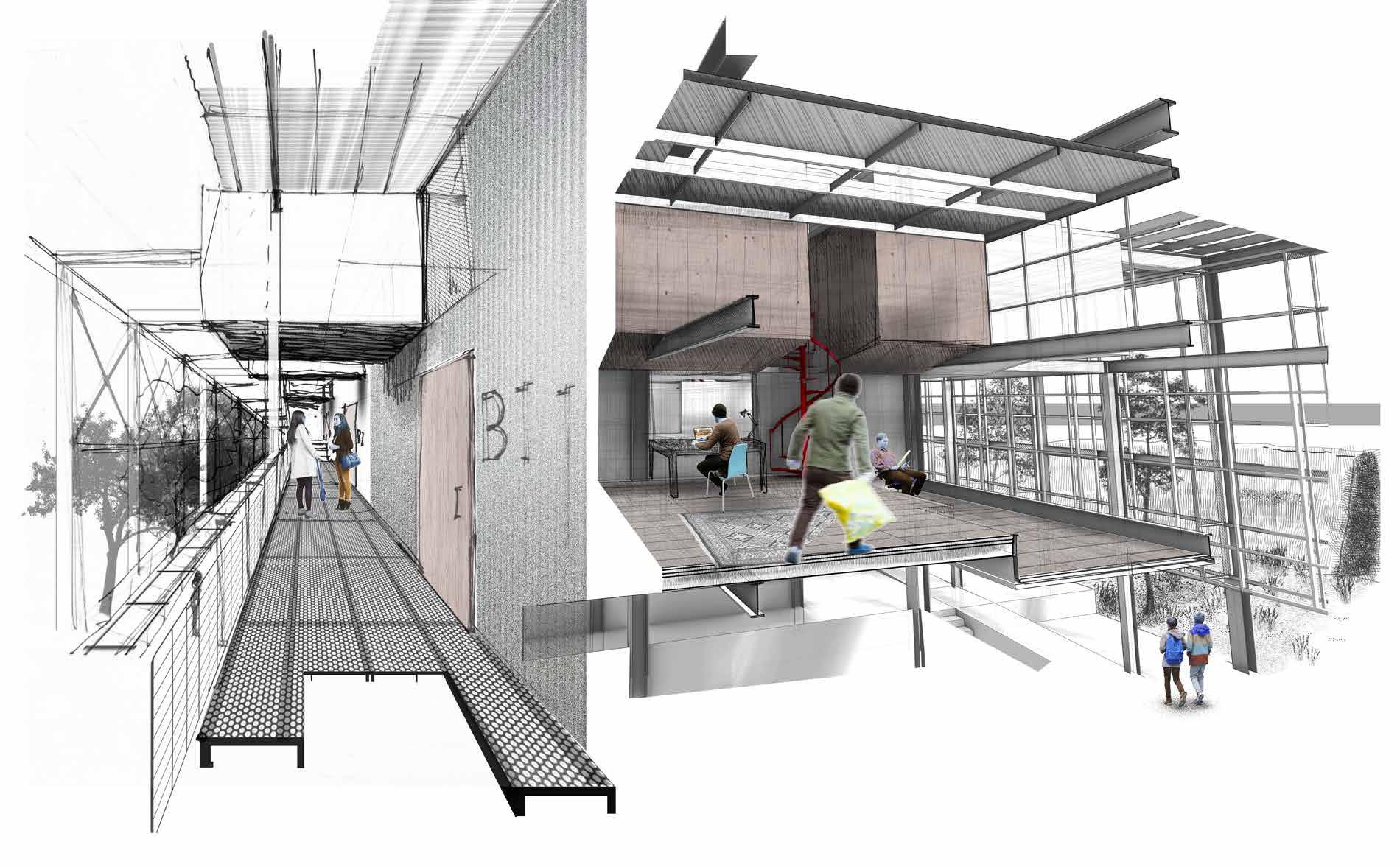
Temporary accommodation spaces designed for researchers who will conduct long-term research are divided into private spaces at the upper levels and public spaces at the ground level. Accommodation areas are organized as apartments consisting of two private rooms and a common space. Accommodating researchers can access the laboratory and archive without leaving the accommodation level and without going out.
Uzun süreli araştırma yapacak araştırmacılar için tasarlanmış geçici konaklama mekanları yukarı kotlarda özel mekanlar, zemin kotunda da kamusal mekan olmak üzere ikiye ayrılıyor. Konaklama alanları iki özel oda ve bir ortak mekandan oluşan daireler şeklinde organize ediliyor. Konaklayan araştırmacılar, konaklama kotundan inmeden ve dışarı çıkmadan laboratuvar ve arşive ulaşabiliyorlar.

Due to the diverse and rich archaeological potential of the region, the need for a facility that is as close to the finds as possible and that can perform the first operations on the finds in various materials has been foreseen.
The laboratories, which form a part of the archaeological part of the institute, have a closed connection with the places where the academicians stay and the multimedia library where the archive is located. Units such as an oven, fume hood and chemistry laboratory can serve both archaeological and geological researches. The open studio located on the ground level makes various uses possible.
Bölgenin sahip olduğu çeşitli ve zengin arkeolojik potansiyel sebebiyle buluntulara olabildiğince yakın ve çeşitli malzemelerdeki buluntulara ilk işlemleri yapabilecek bir tesis ihtiyacı öngörülmüştür.
Enstitünün arkeolojik kısmının bir ayağını oluşturan laboratuvarlar akademisyenlerin konakladığı mekanlarla ve arşivin bulunduğu multimedya kitaplığıyla kapalı bağlantııya sahiptir. İçinde bulunan etüv,çeker ocak, kimya laboratuvarı gibi birimler hem arkeolojik hem de jeolojik araştırmalara hizmet edebilmektedir.
Zemin kotunda bulunan açık stüdyo ise çeşitli kullanımları mümkün kılmaktadır.

infra-twined-structures
Convergence zone of time-varying production, exhibition and market areas + alternative space organization and creation strategy through field definition
MimED 2021 - Project Awards for Architecture Students, 2nd year category/Jury Special Prize
Alsancak Port Region, which was the most important commercial and industrial center of Anatolia in the nineteenth century, turns into a lost place located in the city center but disconnected from the city, with the industrial zones moving to the city periphery and the growth of the city in the 70s.
The project intervenes in the land of the Eastern Industry Institution with a vision that it is included in the city as a post-industrial transformation area where the industrial heritage of the region is preserved.
The possibilities of different spatial and programmatic situations that will occur in the encounter of exhibition and marketplace programs form the basis of the concept. The location of the various production actions that feed these programs according to the infrastructure density is also included in the concept.
Ondokuzuncu yüzyılda Anadolu'nun en önemli ticari ve sanayi merkezi olan Alsancak Liman Arkası Bölgesi, 70'lerde sanayi bölgelerinin kent çeperine taşınması ve şehrin büyümesiyle, kent merkezinde ama kentten kopuk kayıp bir mekana dönüşür.
Proje, bölgenin endüstriyel mirasının korunduğu post-endüstriyel dönüşüm alanı olarak kente dahil olduğu bir vizyon içerisinde Şark Sanayi Müessesesi arazisine müdahale ediyor.
Sergi ve pazaryeri programlarının karşılaşmalarında oluşacak farklı mekansal ve programatik durumların imkanları, konseptin temelini oluşturuyor. Bu programları besleyen çeşitli üretim eylemlerinin altyapı yoğunluğuna göre mekana yerleşme durumları da konsepte dahil oluyor.
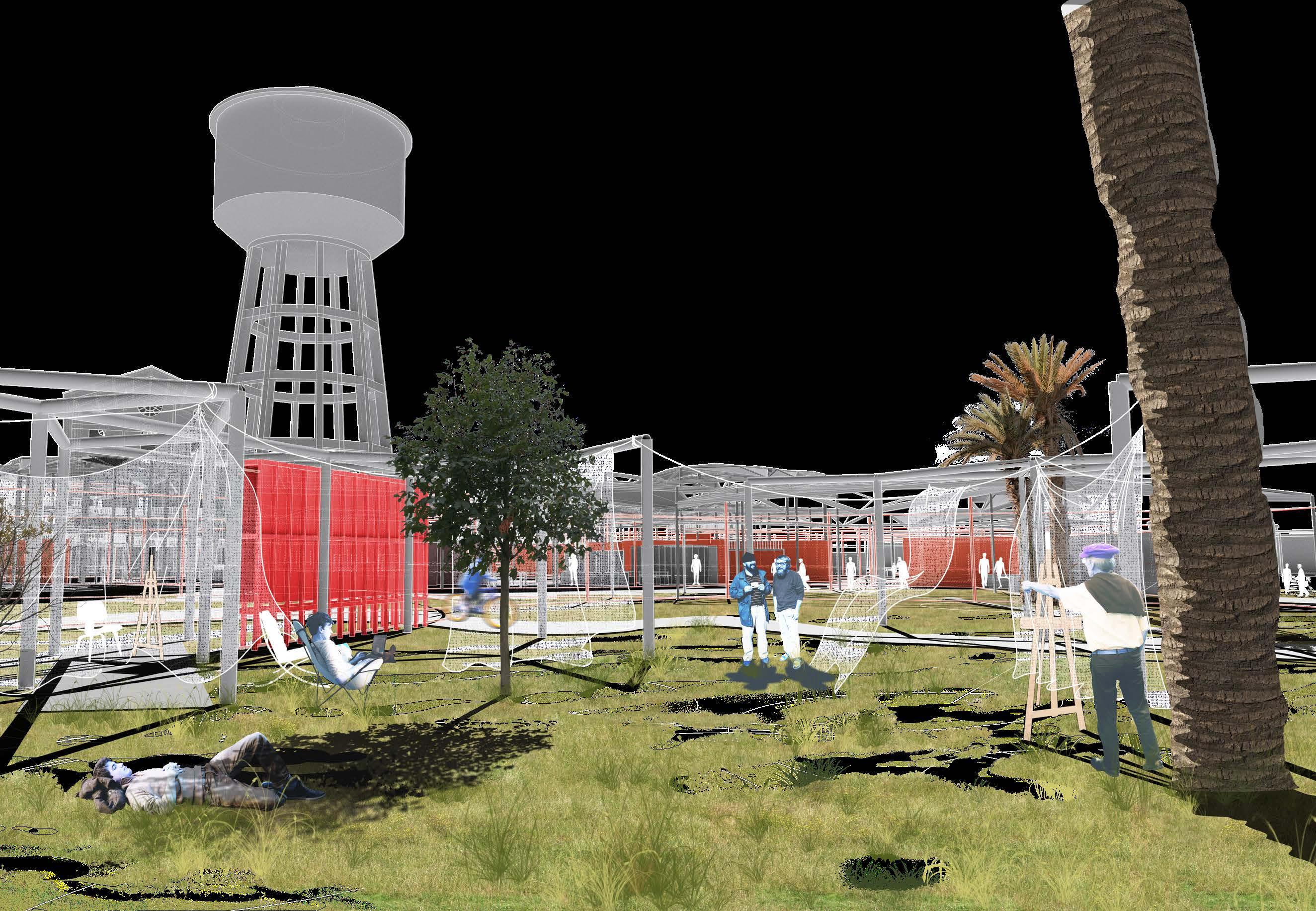

In the building, a cycle based on mutualistic relations was tried to be established between the market vendors, the products sold or exhibited, and the artists and craftsmen who produce. The scrap and antique items sold in the market area are bought by artists, craftsmen and people interested in similar subjects, who use the studios and workshops in this area as workspace, and are used as raw materials for their production. These productions are taken back to the marketplace to be exhibited or sold according to their qualities.
Yapıda Pazar satıcıları, satışı yapılan veya sergilenen ürünler ve üretim yapan sanatçı ve zanaatçılar arasında mutualist ilişkilere dayalı bir döngü kurulmaya çalışılmıştır. Pazar alanında satılan hurdalık eşyaların ve antika eşyalar, bu alandaki stüdyo ve atölyeleri çalışma alanı olarak kullanan sanatçılar, zanaatçılar ve benzer konulara ilgi duyan insanlar tarafından alınarak üretimleri için hammadde olarak kullanılıyor. Bu üretimler niteliklerine göre sergilenmek veya satılmak üzere tekrar pazaryerine götürülüyor.

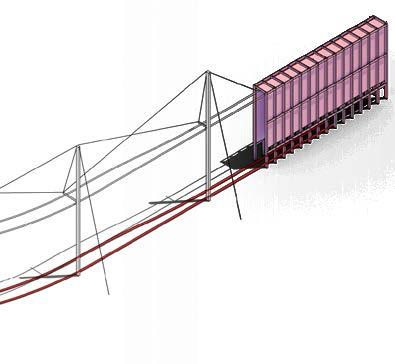
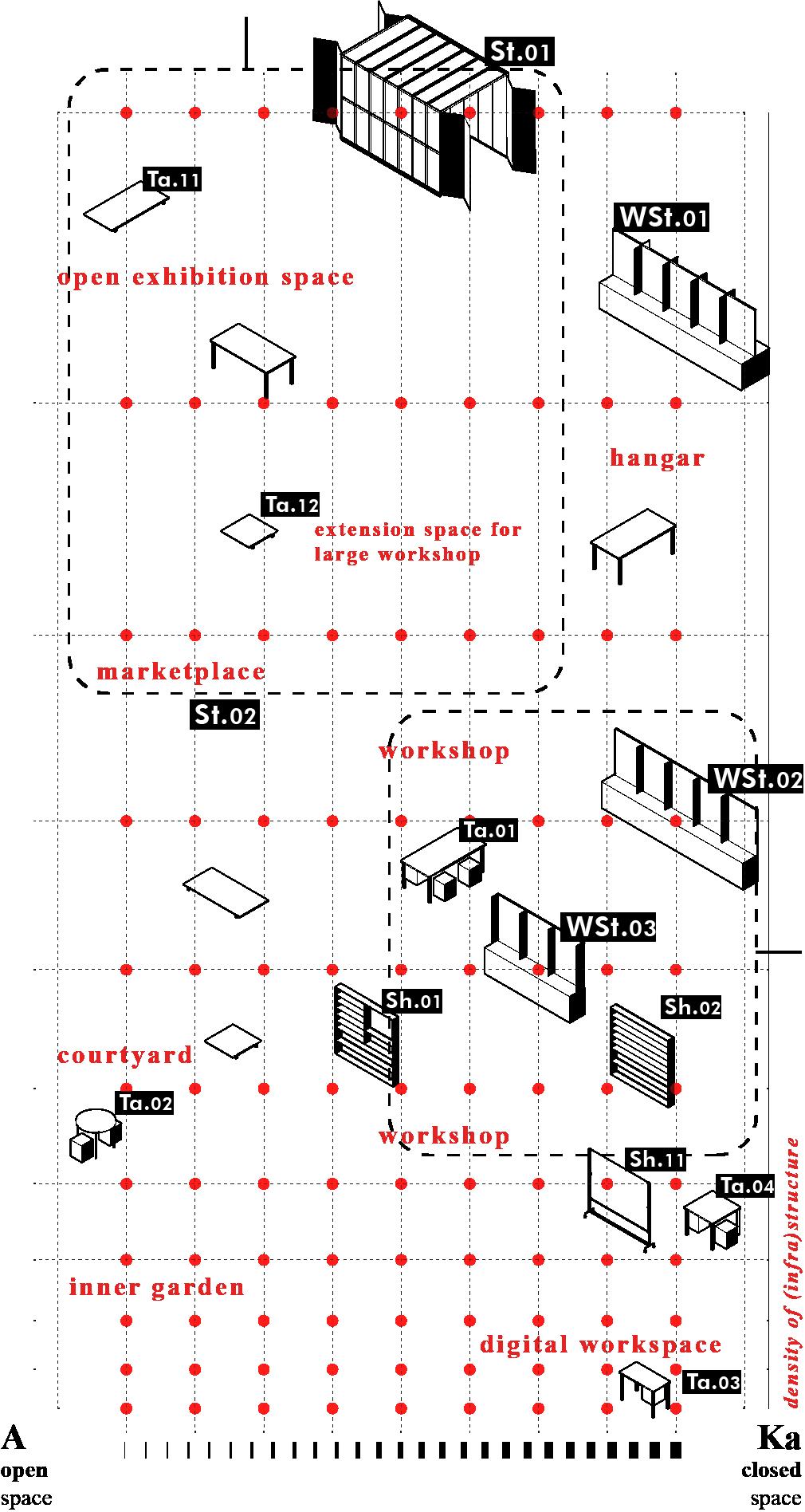

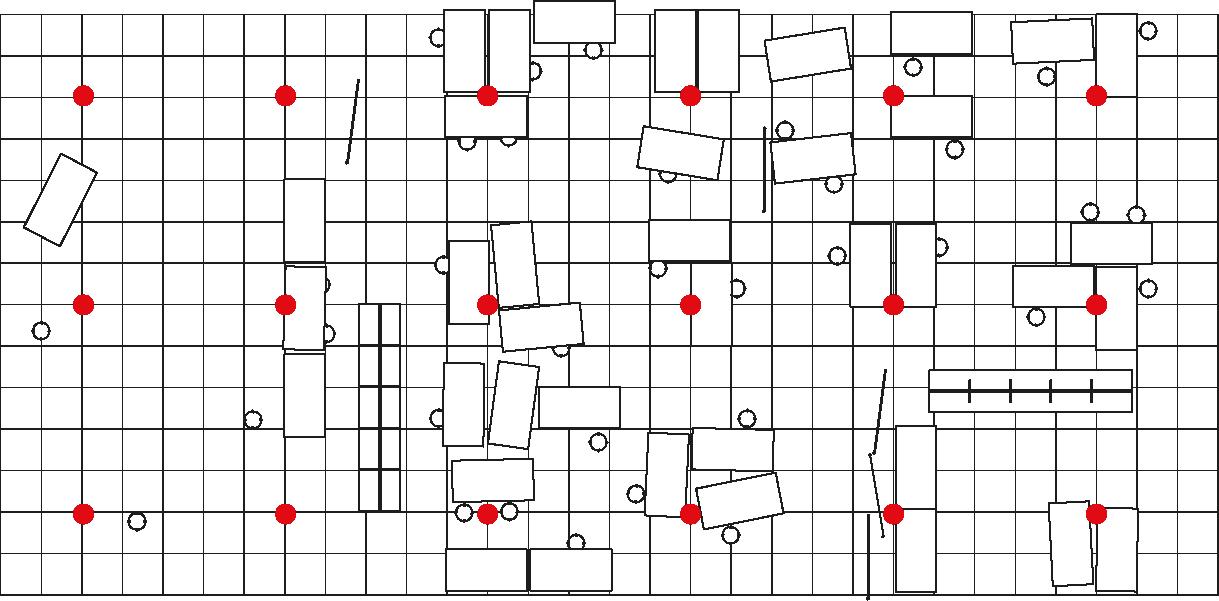
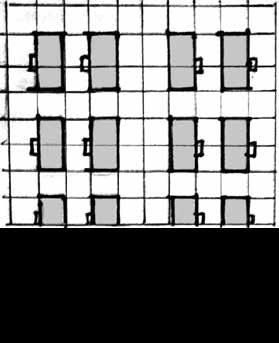
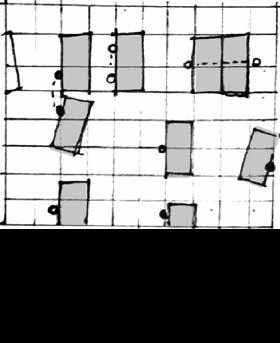

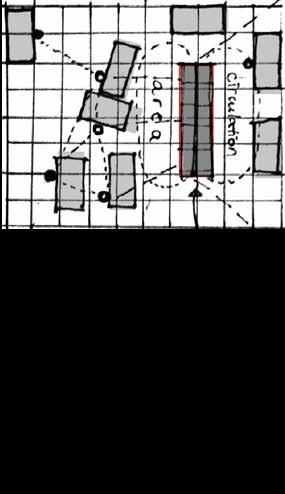
One of the main issues of this project is the inferences made as a result of some examinations about the variables that may affect the possible distributions of the various events taken in the production areas. Some inferences were reached by examining how the homogeneously distributed people and work units would behave depending on various variables in the space, in the absence of any imposition related to the organization of the space, in public spaces or in a place where production is made such as a workshop or studio, which is fixed for a long time. These inferences contribute to the methods applied in the design process.
Üretim alanlarında yapılan çeşitli eylemlerin muhtemel dağılımlarını etkileyebilecek değişkenlerle ilgili bazı incelemeler sonucu yapılan çıkarımlar, bu projenin temel meselelerinden birini oluşturur.
Kamusal alanlarda veya atölye, stüdyo gibi üretim yapılan ve uzun süre -genelde- sabit durulan bir mekanda, mekanın organizasyonuyla alakalı herhangi bir dayatma olmadığı bir durumda homojen olarak dağıtılan insanlar ve çalışma yüzeylerinin mekandaki çeşitli değişkenlere bağlı olarak nasıl davranacaklarını inceleyerek bazı çıkarımlara varıldı. Bu çıkarımlar, tasarım sürecinde uygulanan yöntemlere katkı sağlar.

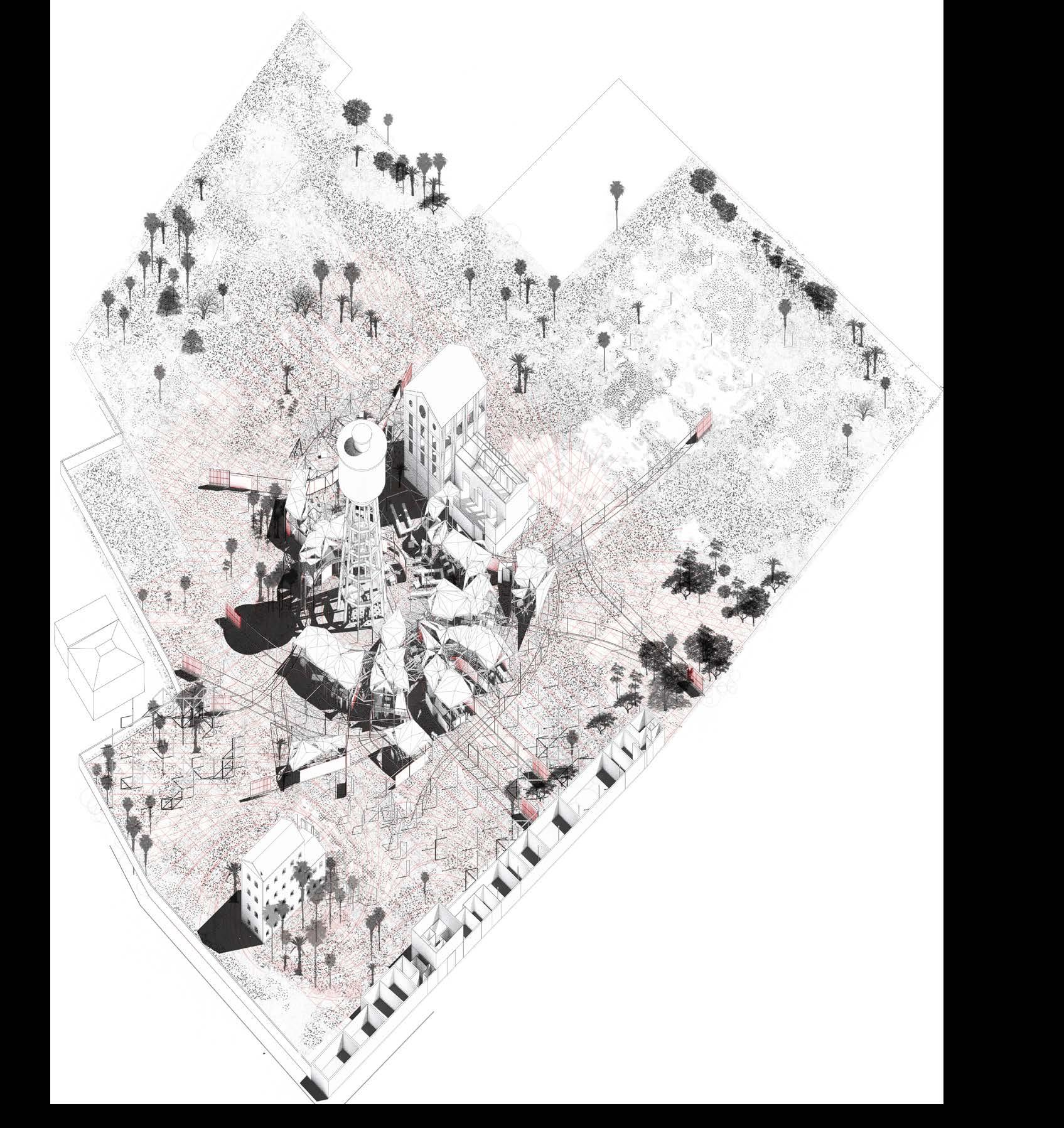

The separating tectonic elements that define the space are the movable panels. These panels can be moved around in various situations and events, allowing for various uses of the space. In cases where the panels are completely closed, they turn into spaces that are isolated from the outside and can be defined more clearly. As the panels begin to open, the outside actions can leak into the spaces that strengthen and dissolve their communication with the outside, and the actions in the space can also leak out and intertwined.
Mekanı tanımlayan ayırıcı tektonik elemanlar hareketli panellerdir. Bu paneller çeşitli durum ve olaylarda hareket ettirilerek alanın çeşitli kullanımlarına izin verir. Panellerin tamamen kapalı olduğu durumlarda dışarıdan izole edilmiş ve tanımları daha net yapılabilen mekanlara dönüşür. Paneller açılmaya başladıkça dışarıyla iletişimi güçlenen ve çözünen mekanlara dışarıdaki eylemlerin sızabildiği gibi mekandaki eylemler de dışarı sızıp iç içe geçebilir.


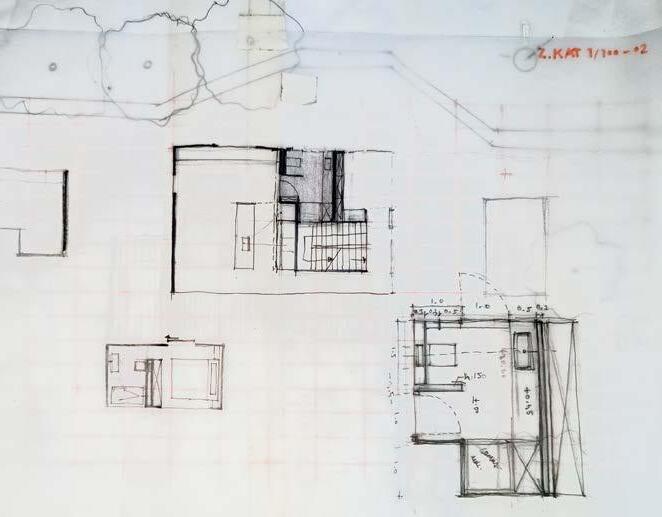
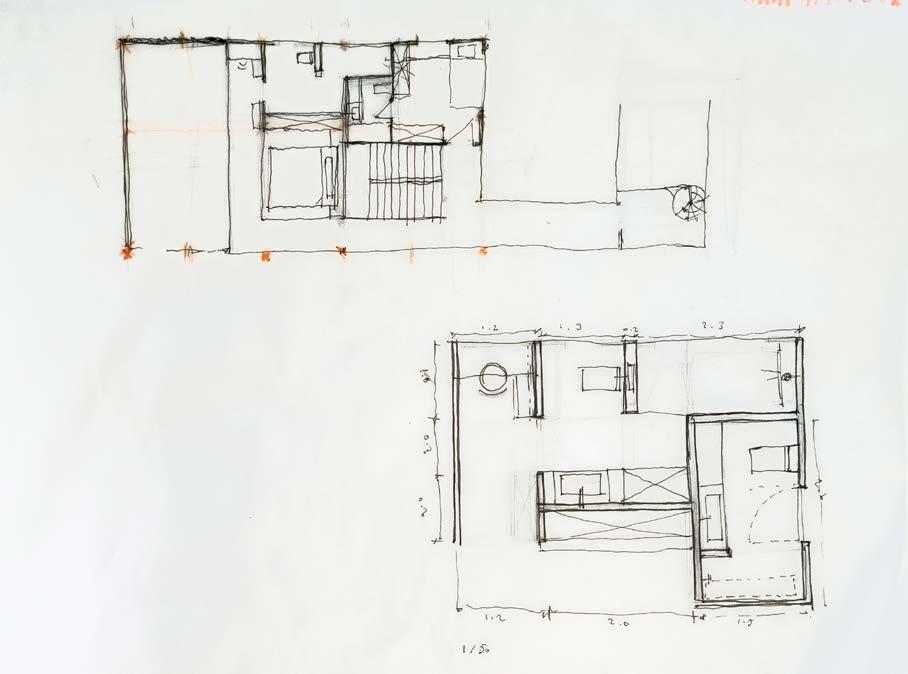

Kaş House
Project, 2022-2023 Fall Term In this architectural construction project, a vineyard house was designed within a large agricultural land in the Bayındır neighborhood of Kaş district of Antalya.
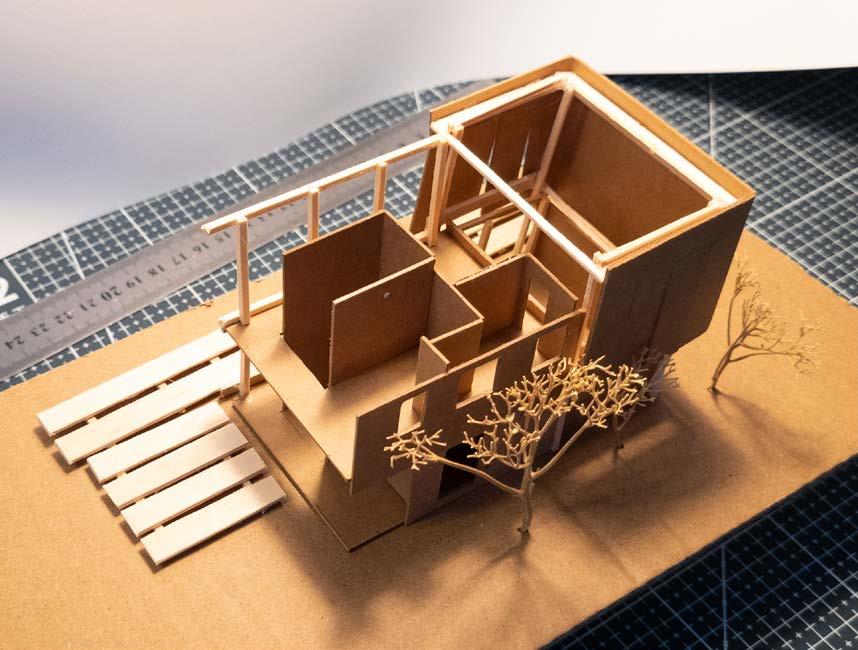
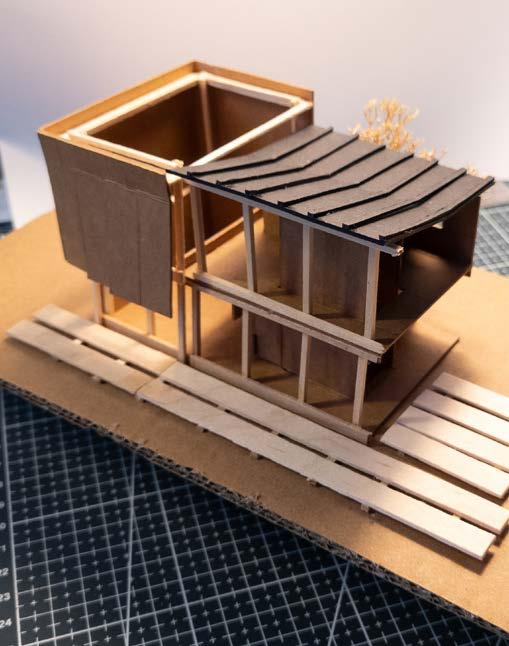
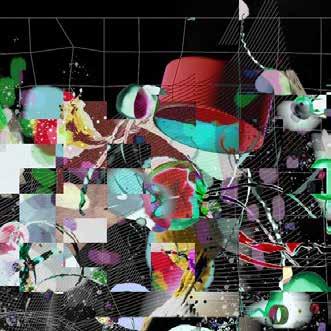


Following the Flow: Change, Expression and Mythology
Digital projection work prepared for the open call of the SeeDjerba art event.
01min | Digital
Edited & Scripted by Mehmet Sait Aktay, Mert Kaan Alptekin and Nazlı Giriftinoğlu
ENG
These images are not a whining lament after “disasters” happened. It is the imagination of not being a kind, of flowing away, of not getting anywhere. The "degenerate" legacy of nature and human, the dream of an artificial memory, is the story of the little things, of the unimportant, of the unheroic. Flow has no beginning or end. Living things, non-living things, objects, words, atoms oscillate in a continuous volume of existence and destruction. Things turn into other things, their boundaries are mixed and blurred, the absolute meaning is lost. The plastic bottle is no longer a plastic bottle, the jellyfish is no longer a jellyfish, the “thing” is not just a "thing" and it is not trapped in the meaning, name, event that is assigned to it.
The flow expresses the judgments of the anthropocene age, the concepts that it confronts and duplicates, those that dissolve and disappear between these dilemmas, those that are ignored, during the period of a wave, the flow of a handful of sand. Primary images and concepts that evoke the phenomena of water, pollution, architecture, and culture are deformed, rifts open in the bodies of their monumentality. The history and future of the present turn into an alternative myth that cannot be read or written. Like everything else, everything the myth has been in the flow occurs, ends and transforms into another.
TUR
Bu imgeler, “felaketler” yaşandıktan sonra sızlanan ağıt değildirler. Bir tür olamamanın, akıp gitmenin, hiçbir yere varamamanın hayalidir. Doğanın ve insanın “yozlaşmış” mirası, yapay bir hafızanın rüyası, küçük şeylerin, önemsiz olanın, kahraman olmayanın hikayesidir. Akışın başlangıcı veya sonu yoktur. Canlılar, cansızlar, nesneler, kelimeler, atomlar sürekli bir varoluş ve yıkım hacminde salınırlar. Nesneler başka şeylere dönüşür, sınırları karışır ve bulanıklaşır, mutlak anlam kaybolur. Plastik şişe artık plastik şişe değil, denizanası artık denizanası değil, “şey” sadece bir “şey” değil ve kendisine yüklenen anlama, isme, olaya hapsolmuş değil.
Akış, antroposen çağının yargılarını, karşılaştığı ve kopyaladığı kavramları, bu ikilemler arasında eriyip kaybolanları, göz ardı edilenleri, bir dalga döneminde, bir avuç kumun akışını ifade ediyor. Su, kirlilik, mimari ve kültür olgularını çağrıştıran temel imgeler ve kavramlar deforme oluyor, anıtsallıklarının bedenlerinde yarıklar açılıyor. Şimdinin tarihi ve geleceği, okunamayan, yazılamayan alternatif bir mite dönüşüyor. Diğer her şey gibi, mitin olduğu her şey akıştadır, gerçekleşir, biter ve bir başkasına dönüşür.
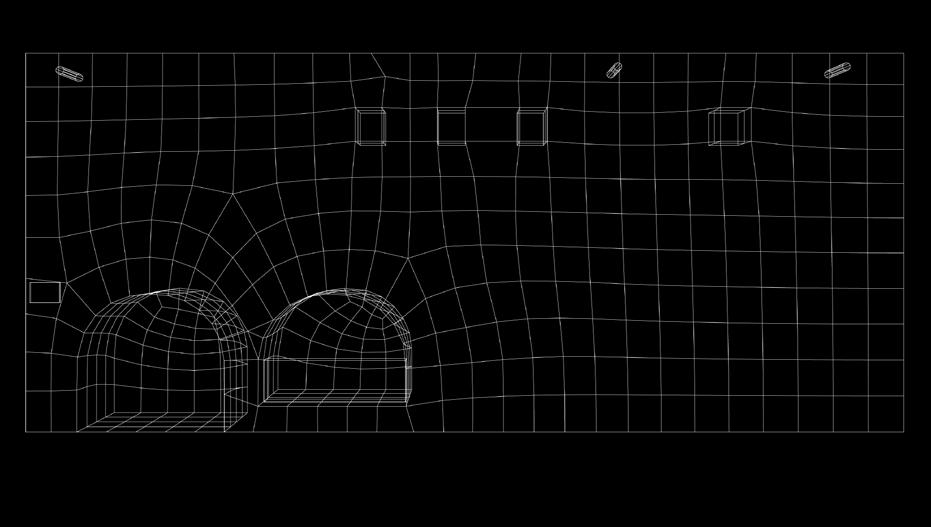
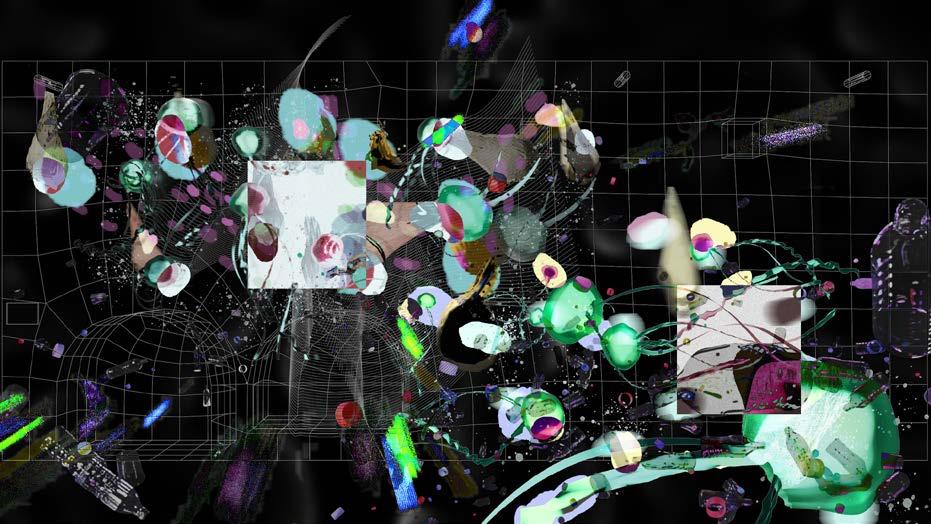




ENG
The fetus comes to the world from the mother's womb. It creates its first perception while positioning itself between the placenta, vagina, and the outside world. It perceives its own body, the borders of its body by being exposed to the pressure of the liquid and soft organism inside the mother individuals and the strokes of the muscles. Discharge, genesis, growing, discharge again. Pleasure, pain, pleasure, pain. Birth and death.. Blood and semen. Oosphere in blood. Uterus. Infinite


























